When starting shoulder training, terms like “Landmine Press” and “Dumbbell Clean and Press” can seem a bit overwhelming.
As a beginner, you might not be familiar with the many shoulder exercises available. It can be hard to try new workouts or understand the different routines if you don’t know the exercises’ names.
But there’s no need to worry! This blog post will provide a comprehensive overview of 100+ standard shoulder exercises, using straightforward names and descriptions.
This shoulder exercise list provides clear images and simple explanations to help you understand shoulder anatomy and each exercise’s mechanics.
Bookmark this guide as your go-to resource for building strong, resilient shoulders.

- Barbell Shoulder Exercises Names
- 1. Military Press
- 2. Seated Barbell Overhead Press
- 3. Barbell Front Raise
- 4. Barbell Upright Row
- 5. Barbell Shrug
- 6. Behind-The-Neck Press
- 7. Barbell Lying Rear Delt Row
- 8. Landmine Press
- 9. Standing Barbell Rear Delt Row
- 10. Clean And Jerk
- 11. Barbell High Pull
- 12. Barbell Chest Supported Rear Delt Row
- 13. Bradford Press
- 14. Standing Wide Grip Shoulder Press
- 15. Close-Grip Military Press
- 16. Single Arm Landmine Shoulder Press
- 17. Barbell Z Press
- 18. Barbell Split Jerk
- 19. Incline Barbell Front Raise
- 20. Wide-Grip Barbell Upright Row
- Dumbbell Shoulder Exercises Names
- 1. Seated Dumbbell Shoulder Press
- 2. Arnold Shoulder Press
- 3. Dumbbell Lateral Raise
- 4. Dumbbell Front Raise
- 5. Dumbbell Upright Row
- 6. Dumbbell Bent Over Raise
- 7. Dumbbell Shrug
- 8. Seated Neutral-Grip Overhead Dumbbell Press
- 9. Dumbbell Lateral Raise
- 10. Incline Bench Rear Lateral Raise
- 11. Dumbbell Chest Supported Lateral Raises
- 12. Standing Dumbbell Rear Delt Fly
- 13. Dumbbell Lateral To Front Raise
- 14. Seated Dumbbell Front Raise
- 15. Dumbbell One-Arm Shoulder Press
- 16. Side-Lying Rear Fly
- 17. Leaning Dumbbell Lateral Raise
- 18. One-Arm Dumbbell Upright Row
- 19. Incline Dumbbell Side Lateral Raise
- 20. Chest Supported Front Raise
- 21. Head-Supported Rear Dumbbell Fly
- 22. Incline Dumbbell Front Raise
- 23. Neutral-Grip Dumbbell Front Raise
- 24. Dumbbell I, Y, T, W Raise
- 25. Dumbbell Cuban Press
- 26. Dumbbell Scaption
- 27. Dumbbell Z Press
- 28. Dumbbell High Pull
- 29. Dumbbell Push Press
- 30. Dumbbell Clean and Press
- Cable Shoulder Exercise Names For Gym Workout
- 1. Cable Shoulder Press
- 2. Cable Front Raise
- 3. Single Arm Cable Front Raise
- 4. Cable Upright Row
- 5. One Arm Cable Lateral Raise
- 6. Cable Lateral Raise
- 7. Cable Machine Y Raise
- 8. Bent Over Cable Lateral Raise
- 9. One-Arm Bent Over Cable Raise
- 10. Reverse Cable Crossover
- 11. Lying Reverse Fly (Supine Cable Reverse Fly)
- 12. Cable Twisting Overhead Press
- 13. Face Pull
- 14. Cable Shrug
- 15. Cable High Row
- 16. Cable Rear Delt Row
- 17. Alternating Cable Shoulder Press
- 18. Standing Cable Rear Delt Row With Rope
- 19. Cable External Rotation
- 20. Cable Internal Rotation
- GYM Machine Shoulder Exercises With Names
- 1. Shoulder Press Machine
- 2. Smith Machine Seated Shoulder Press
- 3. Reverse Machine Fly
- 4. Smith Machine Upright Row
- 5. Machine Lateral Raise
- 6. Smith Machine Shrug
- 7. Smith Machine Behind The Neck Shoulder Press
- 8. Shrug Machine
- 9. Rowing
- 10. Behind The Back Smith Machine Shrug
- Name Of Bodyweight Shoulder Exercises
- 1. Pike Push Up
- 2. Incline Push-Ups
- 3. Side Plank
- 4. Bird Dog Exercise
- 5. Plank To Push-Up
- 6. Tabletop Reverse Pike
- 7. Crab Walk
- 8. Hindu Push Up
- 9. Archer Push-Up
- 10. Shoulder Tap Push Up
- 11. Stability Ball Push Up
- 12. High Reverse Plank
- 13. Inverted Row
- 14. Clapping Push-Up
- 15. Elevated Pike Push-Up
- 16. Handstand Push Up
- 17. Bear Crawl
- 18. Arm Circles
- 19. Wall Walk
- 20. Scapular Wall Slides
- 21. Alternating Superman Plank And Reach
- 22. Lateral Plank Walk
- 23. Scapula Push Ups
- Conclusion
Barbell Shoulder Exercises Names
The barbell is a good tool for heavy lifting. It helps you work hard and strengthens your shoulders.
This section will introduce more than 15 renowned barbell shoulder exercises, with detailed descriptions and illustrative images.
The exercises will cover variations such as barbell overhead shoulder presses, front raises, upright rows, and more.
1. Military Press
If you’re looking for straightforward barbell shoulder exercises to add to your home routine, the Overhead Press is a great staple exercise to get you started.
The military press is used primarily to build the deltoid muscle. It also indirectly targets the other shoulder muscles, the triceps, and the core.
Since the military press is completed standing up, it involves a lot of core strength to help stabilize the spine while pressing weight overhead.
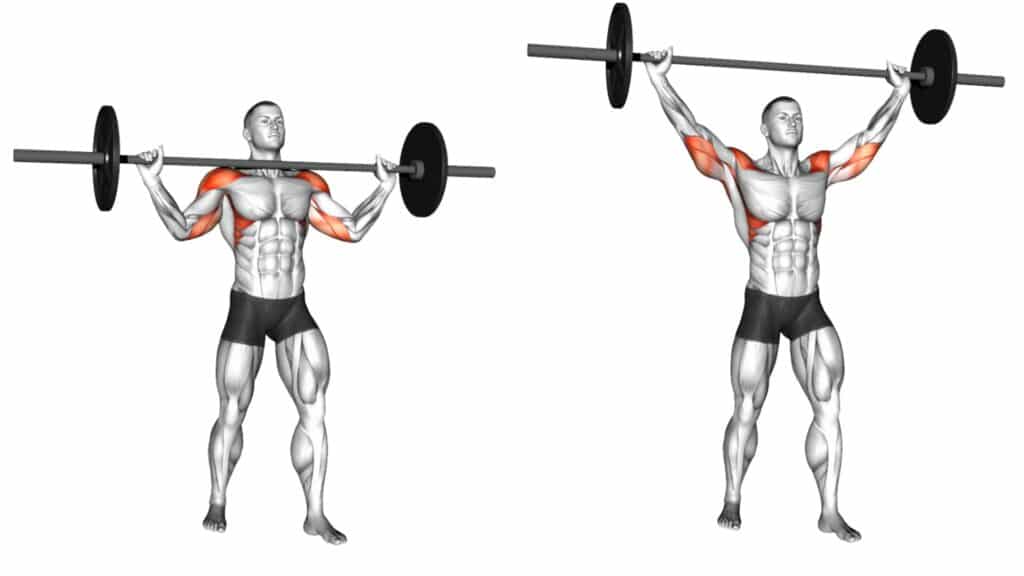
2. Seated Barbell Overhead Press
This is one of the best shoulder exercises you can do at home or in the gym during your upper body workout. The shoulder Press remains the granddaddy of all shoulder exercises for building big, round shoulder muscles.
The seated barbell overhead press is a compound exercise that works the deltoids, triceps and trapezius.
This exercise is similar to the overhead press but is performed while sitting on a bench to help stabilise the body.
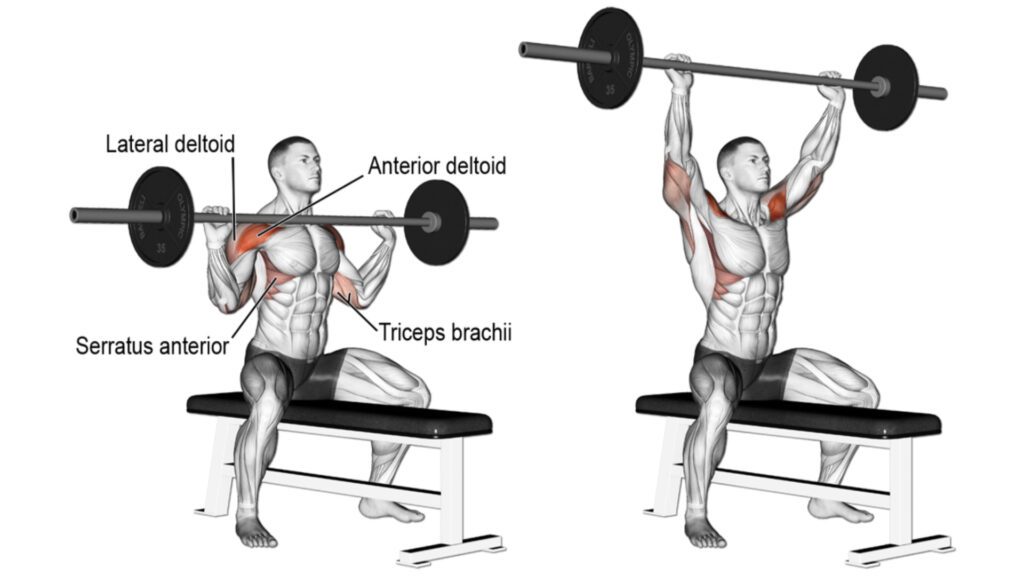
3. Barbell Front Raise
The barbell front raise is a shoulder exercise to target the front deltoids.
It involves lifting a barbell in front of the body while keeping the arms straight, making it an effective way to isolate and strengthen the shoulders.
It is possible to overload the muscles with the barbell to a greater degree than one may be capable of doing with dumbbells.
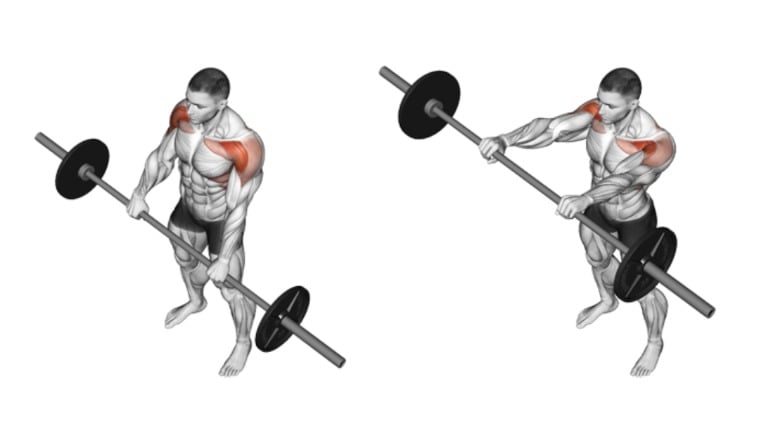
4. Barbell Upright Row
The barbell upright row is an excellent exercise you can do at home to build huge Trapezius muscles.
Research shows that the upright row is one of the best exercises for building shoulder strength and stability.
The exercise targets the smaller, stabilizing muscles of the shoulder joint. The enhanced strength and stability gained from this exercise may improve performance in sports and other physical activities.
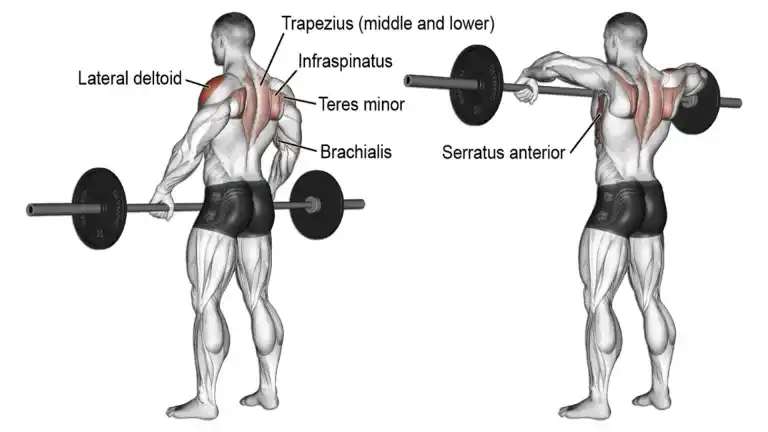
5. Barbell Shrug
The Barbell Shrug is one of the best shoulder exercises for building bigger and stronger trap muscles at home. It is also one of the easiest trap exercises to perform.
It is also a popular exercise choice for strengthening the Trapezius, upper back, shoulder muscles, neck, and upper arms.
A study has shown that shrugging helps relieve shoulder and neck pain. It also helps to improve posture.
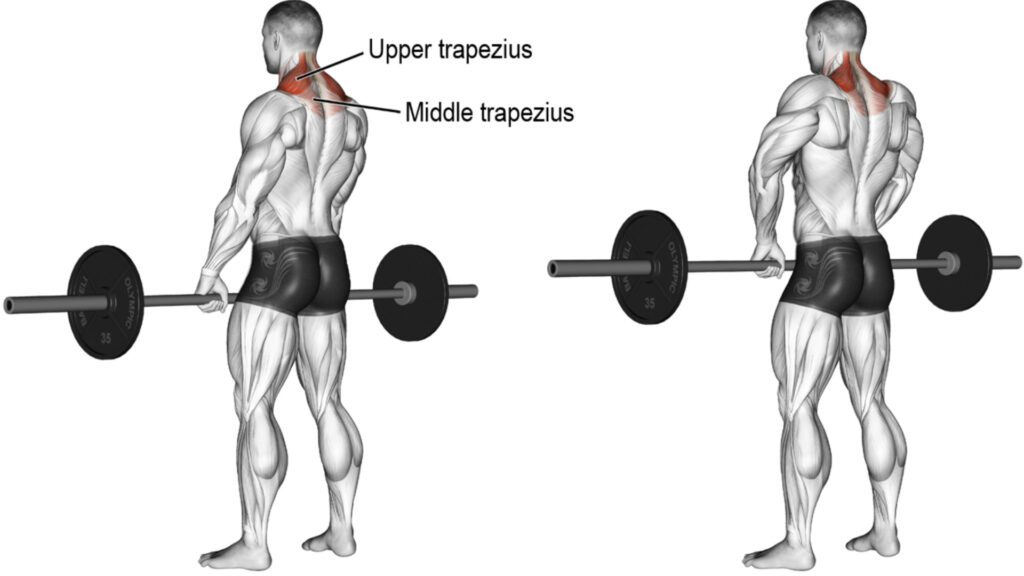
6. Behind-The-Neck Press
A behind-the-neck press targets your shoulders. The standard military press and the overhead dumbbell press hit more of the anterior head of the deltoid, which is often stimulated a lot, even during the bench press.
On the other hand, it stimulates all three heads of the shoulder and recruits the triceps, traps, and rhomboids.
Performing these barbell shoulder exercises is not recommended if you do not have adequate shoulder mobility.
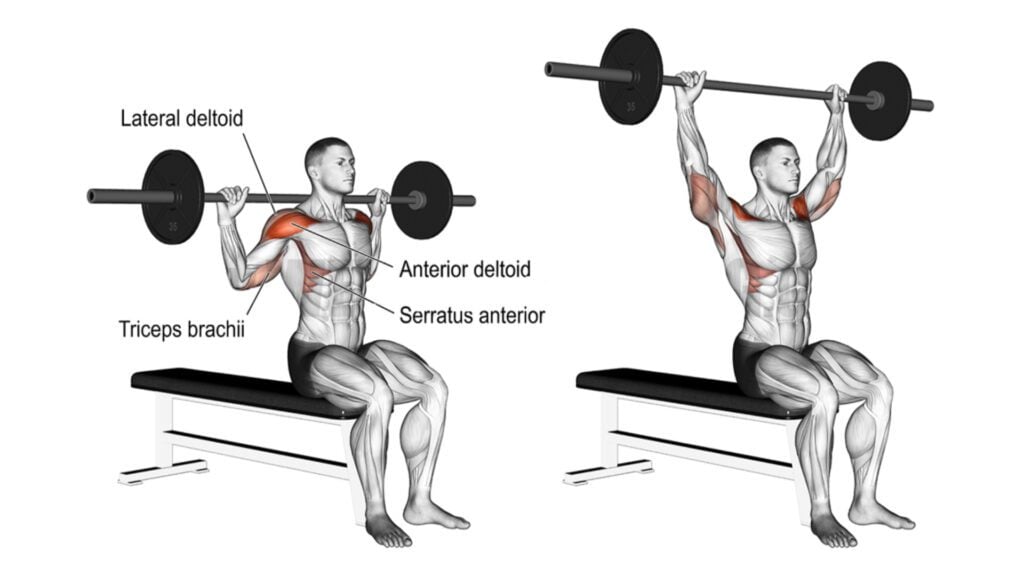
7. Barbell Lying Rear Delt Row
The barbell lying rear delt row is an exercise primarily targeting the rear deltoids, upper back, and rhomboids. When done correctly, it can effectively target your shoulders and upper body.
Including the barbell lying rear delt row in your workout will help you work on all three parts of your shoulder: the front, back, and sides.
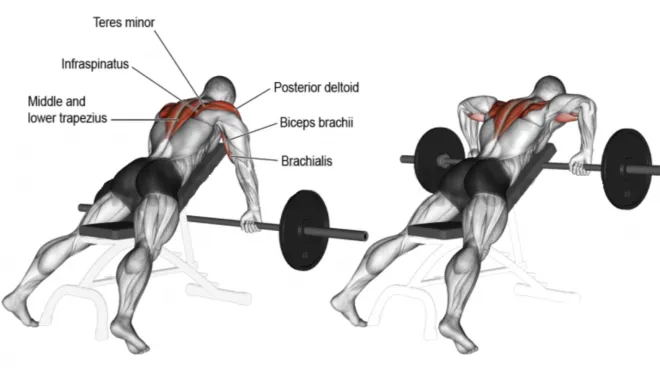
8. Landmine Press
The Landmine Press is not a popular exercise, yet it provides many benefits, including progressing your inner and upper chest and the muscles that work alongside them—the triceps and the deltoids.
It can be performed in a kneeling position, which increases core involvement and can improve core stability and abdominal muscle strength.
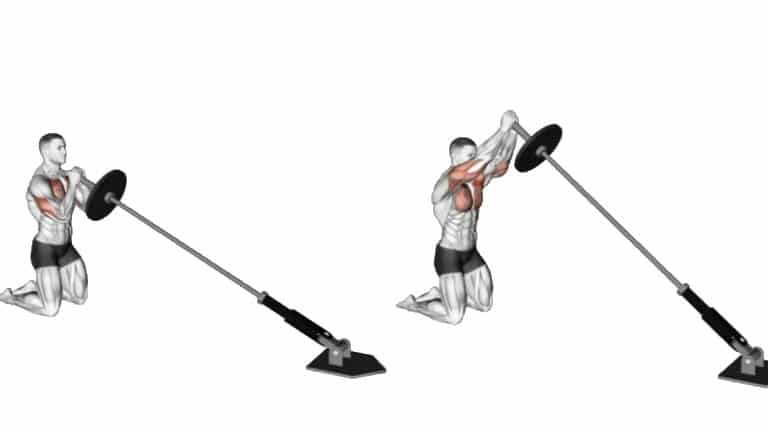
9. Standing Barbell Rear Delt Row
Unlike bent-over barbell rows, the standing barbell row provides more rear delt emphasis by allowing you to pull the barbell back towards your upper chest rather than your lower ribs.
It is an effective back exercise that targets your rear deltoid muscles. By hitting the lats, traps, rhomboids, and biceps, this move builds impressive “3D” back thickness while improving posture.
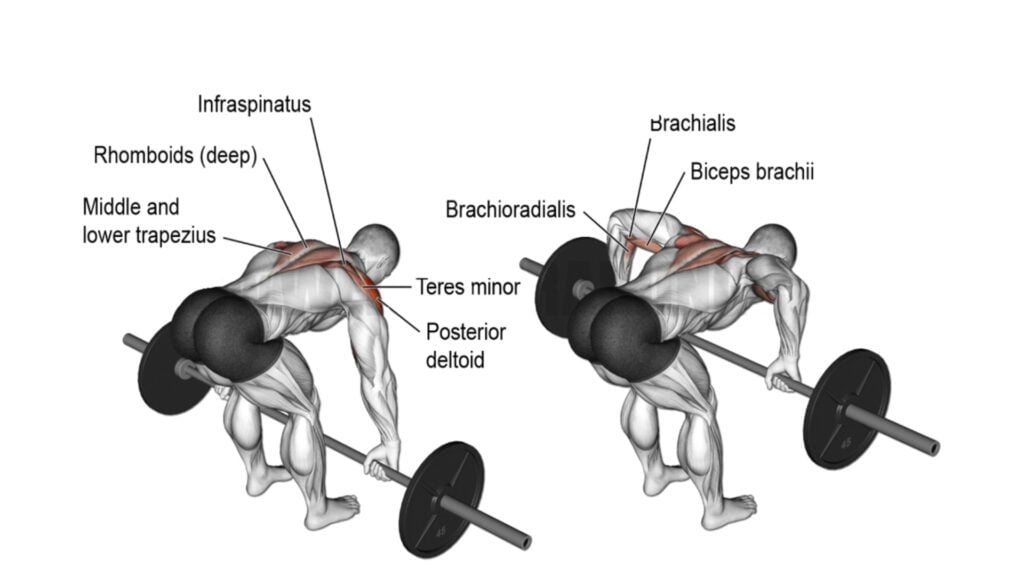
10. Clean And Jerk
The hang clean and jerk is a complex exercise that involves multiple movements performed in quick succession.
It requires to be coordinated flexion and extension of various joints and muscles throughout the body, combining pulling and pushing motions into a single exercise.
It is an effective and efficient way to achieve a full-body workout quickly.
It is also one of the lifts that athletes perform at events like the Olympics and other weightlifting competitions.
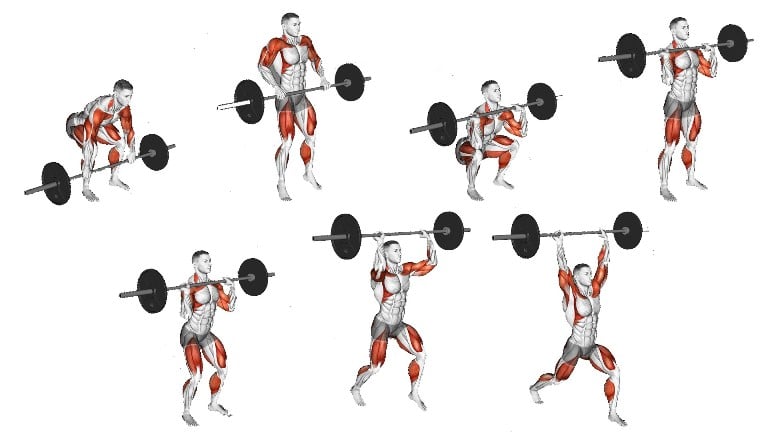
11. Barbell High Pull
The Barbell High Pull is an explosive multijoint workout focusing on the upper body, including the arms, upper back, and traps. It’s a good way to become more athletically strong.
- Stand with your feet shoulder-width apart and hold a barbell.
- From this position, explosively extend hips, knees, and ankles, pulling the barbell towards your chin.
- Raise the bar to chest or shoulder height, no higher.
- Carefully lower the bar back to the starting stance.
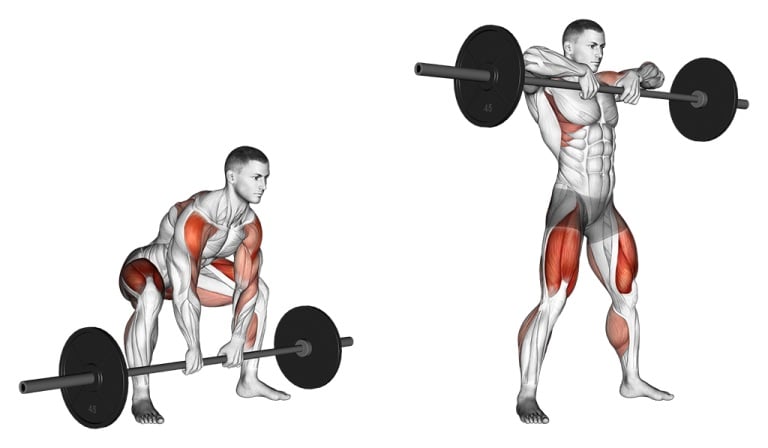
12. Barbell Chest Supported Rear Delt Row
The chest-supported row exercise is an effective variation of the bent-over barbell row. As the name suggests, it involves rowing with your chest supported. This highly effective exercise also minimises lower back strain.
In other words, this variation requires less effort to stabilize body position during the row because the chest is supported on the bench.
This row is much more effective for targeting the back muscles because it doesn’t require other muscles to stay stable throughout the movement.
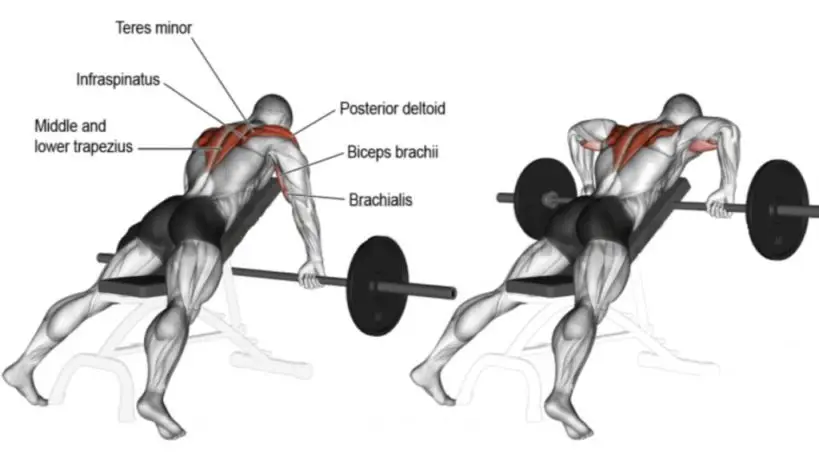
13. Bradford Press
The Bradford Press involves alternating barbell presses to the front and back of the head without fully locking out the arms.
It targets multiple parts of the deltoids: anterior (front), medial (side), and posterior (rear) deltoids.
- The exercise starts with a shoulder-high barbell in front of the neck.
- Press the barbell, then move it just over and behind the head.
- You then reverse the movement to bring the barbell back to the front.
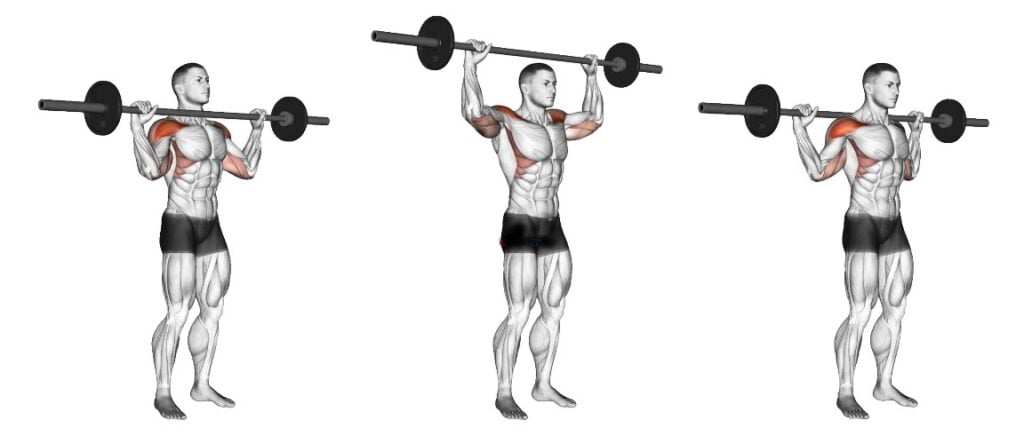
14. Standing Wide Grip Shoulder Press
This exercise is done standing and using a barbell with a wider grip than your shoulder width.
Some Benefits:
- The wider grip can increase the recruitment of the lateral (side) deltoids.
- It may also involve the upper chest and trapezius muscles to a greater extent.
- Some people find that a wider grip can reduce discomfort in the shoulder joint.
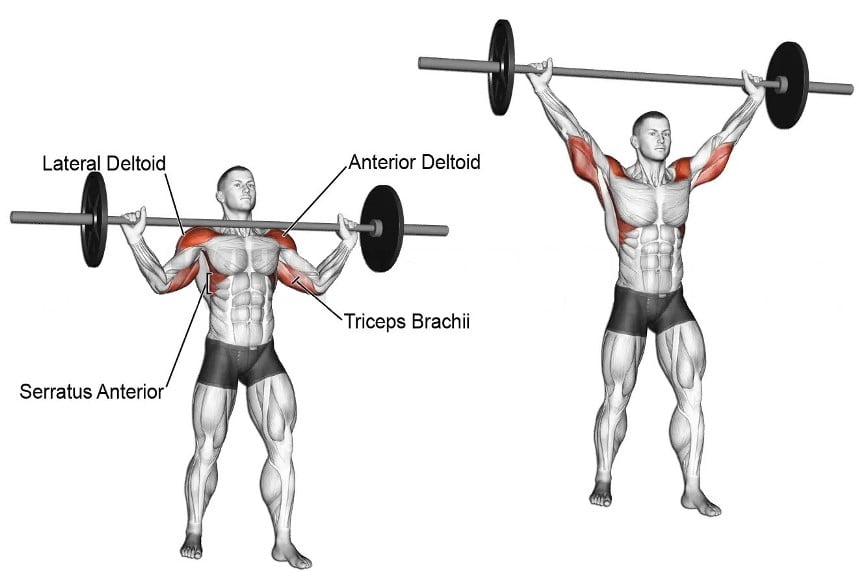
15. Close-Grip Military Press
The close-grip military press is a great way to work your triceps and shoulders more than the usual overhead press.
This exercise uses a narrower hand placement than the traditional shoulder-width grip.
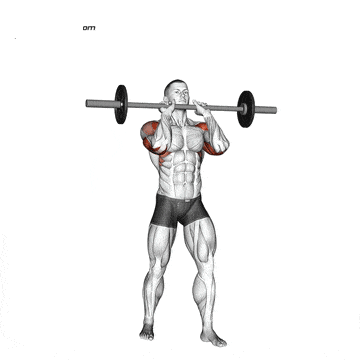
16. Single Arm Landmine Shoulder Press
The landmine shoulder press is a shoulder exercise that significantly strengthens your upper body.
The landmine press is the best alternative to the overhead press, which is a little easier on the joints without compromising strength and muscle size benefits.
The exercise primarily targets the shoulders, chest, and triceps muscles. It also engages the core, back, and legs to provide stability.
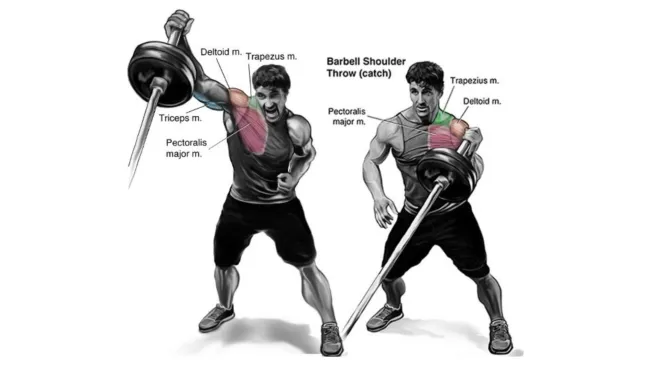
17. Barbell Z Press
The Barbell Z Press is a challenging and effective shoulder exercise that strongman Zydrunas Savickas popularised, hence the name.
A barbell is used to perform the Z Press while sitting on the floor with legs extended forward.
This seated position eliminates leg drive and lower-body assistance, making it a pure upper-body workout.
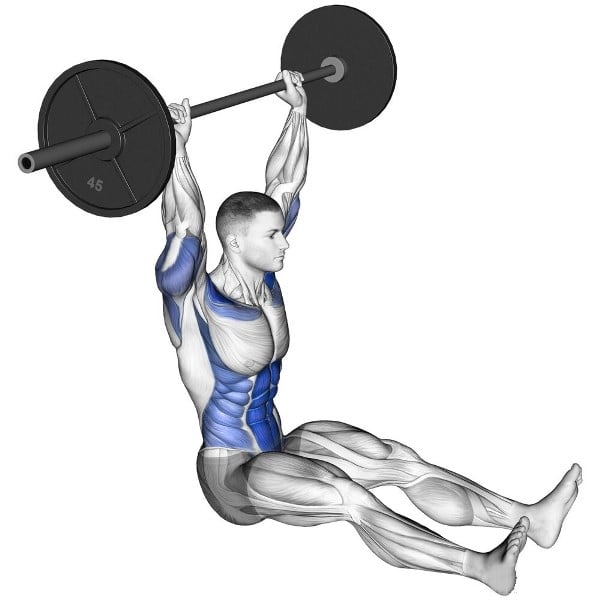
18. Barbell Split Jerk
The Barbell Split Jerk is a powerful and dynamic exercise primarily performed in Olympic weightlifting.
It is also popular among athletes and strength trainers for its ability to develop explosive power, coordination, and strength. It produces explosive strength in the legs, hips, and shoulders.
Furthermore, it is a compound exercise that involves lifting a barbell overhead and splitting the legs into a lunge position.
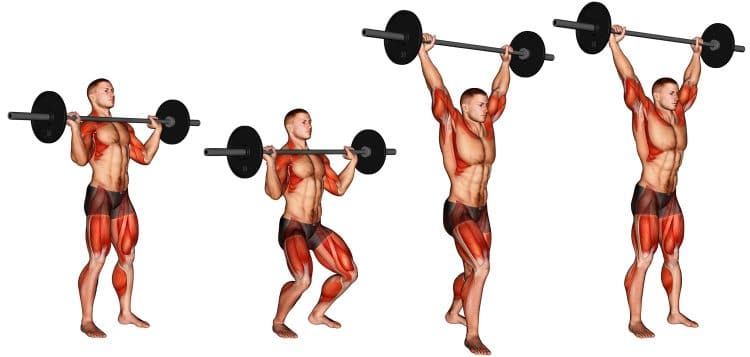
19. Incline Barbell Front Raise
It is a variation of the traditional front raise exercise focusing on the anterior (front) deltoid muscles.
This exercise is done with an incline bench, which changes the angle of resistance and uniquely challenges the shoulder muscles.
- Set an incline bench to about 30–45 degrees. Lie face down on the bench.
- Grip a barbell with both hands, palms facing down.
- Lift the barbell up in front of you to shoulder height.
- Lower the barbell back down to the starting position.
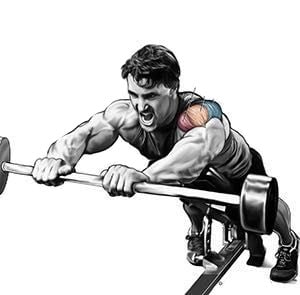
20. Wide-Grip Barbell Upright Row
The wide-grip barbell upright row is preferable to the regular upright row because it prevents the elbows from going too high, preventing rotator cuff injuries.
The wide-grip upright row places heavy emphasis on the lateral and rear deltoid and little less on the upper and middle trap
Furthermore, the wider grip allows some cheating movement, allowing you to lift more weight.
It may also be more shoulder-friendly for people who cannot handle the close-grip version.
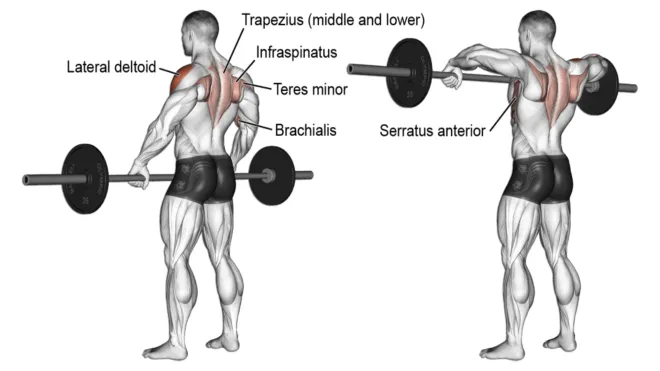
Dumbbell Shoulder Exercises Names
Dumbbells are an effective and dynamic way to target your shoulder muscles. They focus on strength, endurance, and symmetry.
The good thing about using dumbbells for shoulder exercises is that they can work on each side of the shoulders separately, which helps to fix muscle imbalances.
This list includes over 20 exercises specifically designed to build shoulder muscles. Each exercise has brief descriptions and illustrations.
1. Seated Dumbbell Shoulder Press
Dumbbell Shoulder presses are an excellent variation of barbell shoulder Presses. The dumbbells allow a full range of motion.
It is one of the best exercises for building shoulder mass and strength, especially the front and side deltoid muscles.
They perform the exercise while seated. The shoulder press is a stricter version than standing and prevents cheating by lifting the weight upward using momentum generated by the legs.
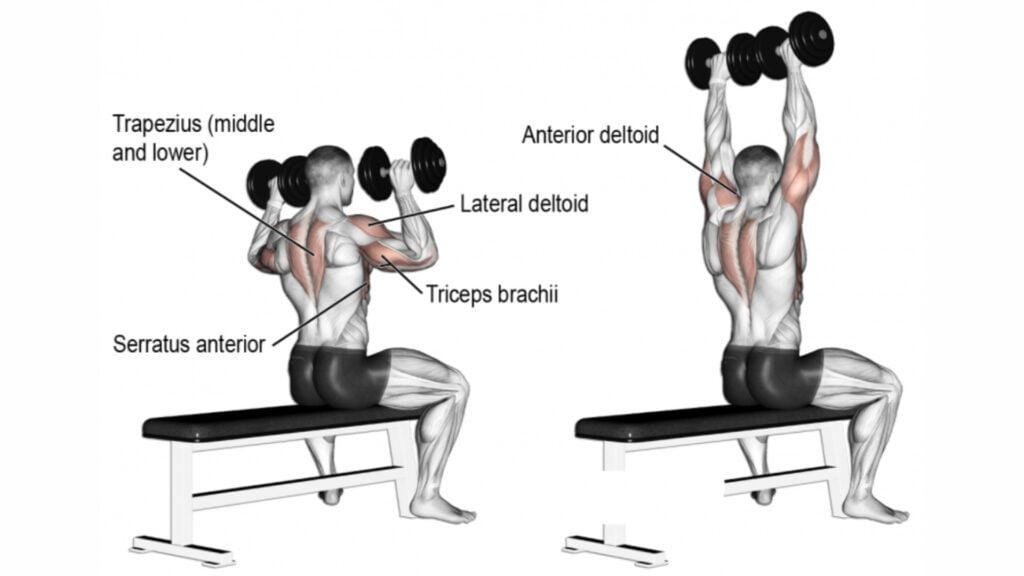
2. Arnold Shoulder Press
The Arnold dumbbell shoulder press is an excellent exercise for building shoulder muscles. Arnold’s press stands out from the crowd regarding the best dumbbell exercise for shoulder muscles, with the best range of motion.
It provides a wide range of motion as you lower the dumbbells well down in front, allowing you to achieve the maximum stretch that other shoulder exercises lack.
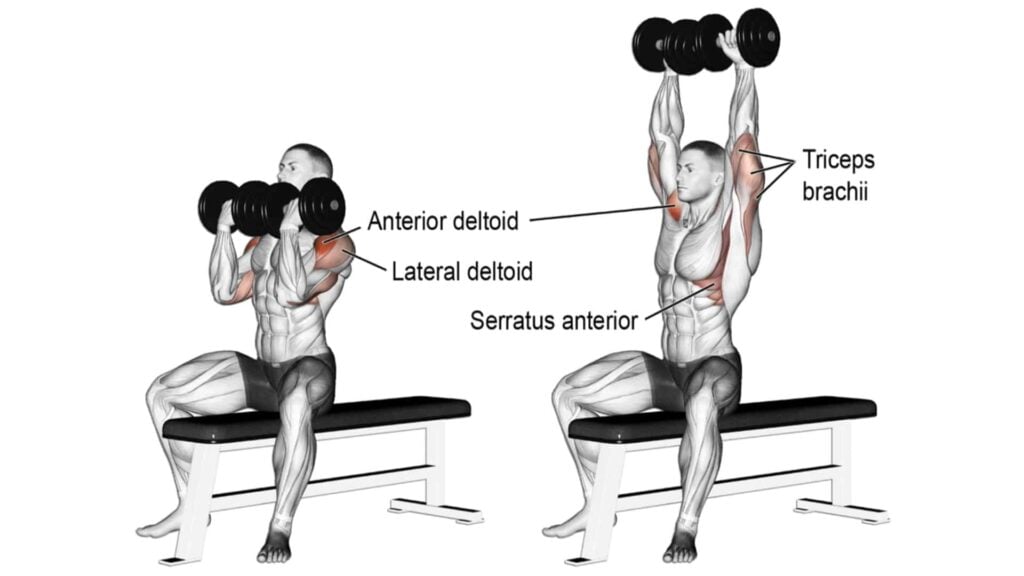
3. Dumbbell Lateral Raise
The side lateral raise with dumbbells works the side of the shoulders, also called the lateral head. It’s an isolation exercise that primarily targets the lateral head of the shoulder.
As a lighter weight is used, more reps can be used — anything from 10 to 20 reps.
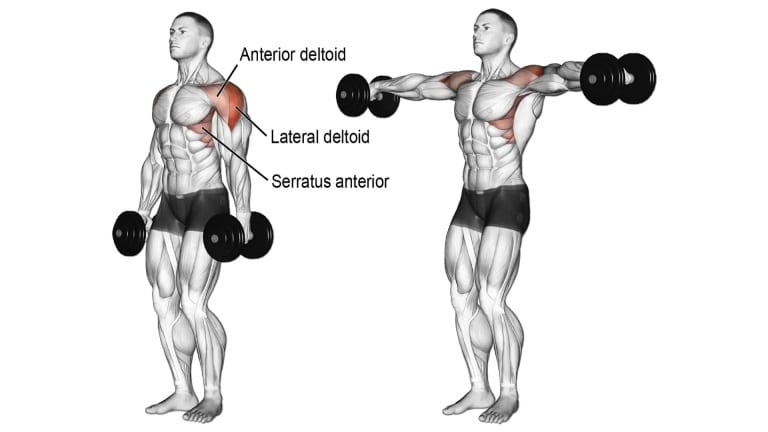
4. Dumbbell Front Raise
A dumbbell front raise is an excellent exercise for isolating the anterior deltoid Muscle and building muscle mass in the front head of the deltoids.
This exercise can work well with a medium to lightweight for higher reps.
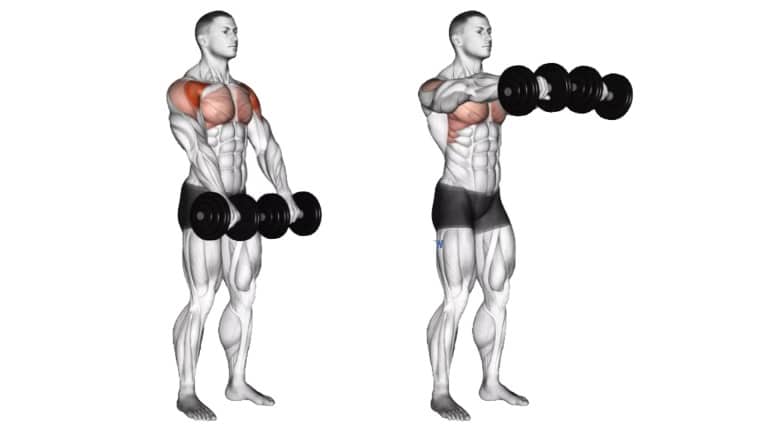
5. Dumbbell Upright Row
Research shows that the upright row is one of the best exercises for building shoulder strength and stability. It activates all major shoulder areas and excels at upper body stability and conditioning.
The dumbbell upright row can target your shoulders or traps, depending on how wide or narrow you keep your elbows during the movement.
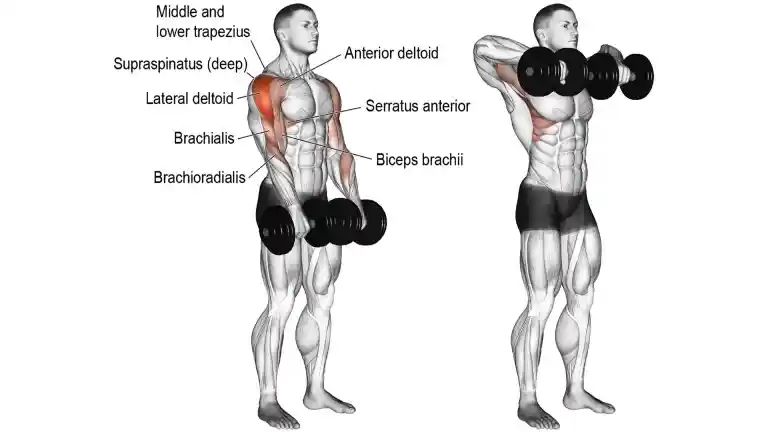
6. Dumbbell Bent Over Raise
If you want to build a bigger and stronger rear delt, you should add bent-over lateral raises to your shoulder workout routine.
This exercise hits the rear deltoid head explicitly and isolates it better than any other shoulder exercise.
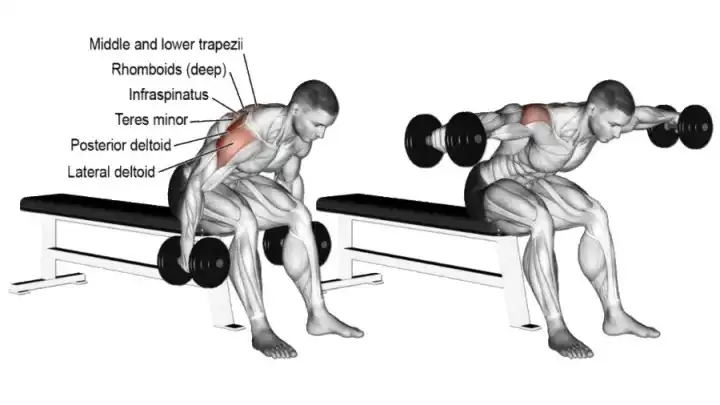
7. Dumbbell Shrug
The dumbbell shrug is a great exercise for building shoulder strength, improving posture, and relieving neck and shoulder pain.
This isolation exercise builds bigger, stronger trapezius muscles, specifically the upper trapezius muscles.
They are suitable for both beginners and pros because they can be performed with various weights.
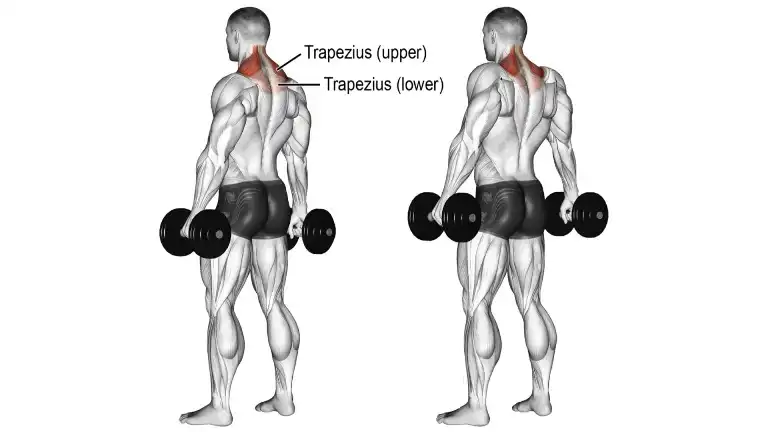
8. Seated Neutral-Grip Overhead Dumbbell Press
The seated neutral-grip overhead dumbbell press is a fantastic exercise for building strength and definition in your shoulders, particularly your anterior and lateral deltoids.
It’s a variation of the traditional overhead press but with a neutral grip instead of a pronated (overhand) or supinated (underhand) grip.
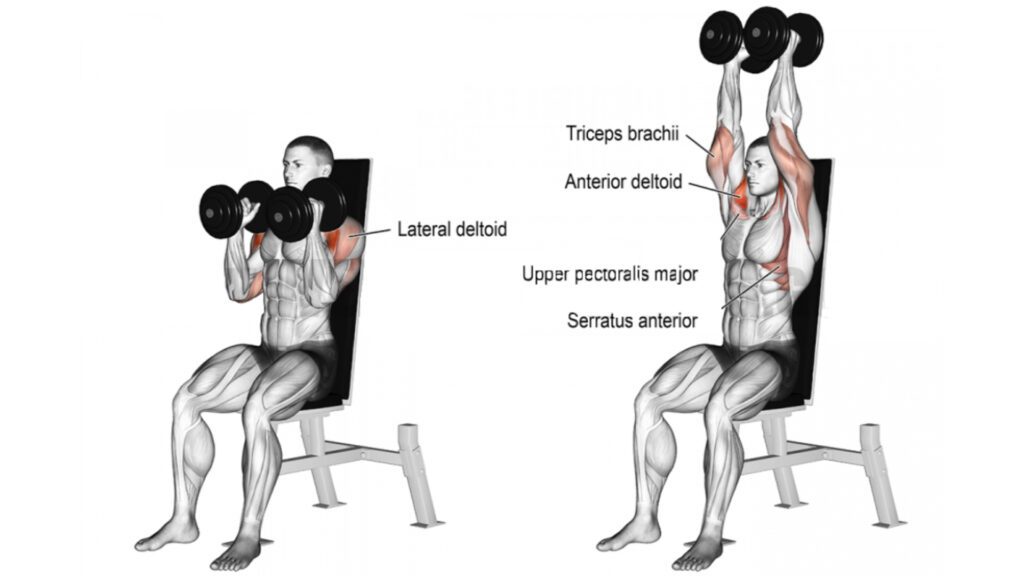
9. Dumbbell Lateral Raise
Dumbbell lateral raise is a simple yet effective exercise that can help you target the shoulders, particularly the lateral or middle deltoid muscles.
Many variations of the dumbbell lateral raise challenge your muscles even more and help build strength and definition.
Some examples of variations include single-arm raises, chest-supported side raises, and dumbbell lateral-to-front raises.

10. Incline Bench Rear Lateral Raise
The incline bench rear lateral raise is an upper-body exercise that targets the posterior or rear deltoids and the postural muscles of the upper back.
Because it targets such small muscles, this exercise is usually performed with lightweight for high reps, such as 10-15 reps per set or more.
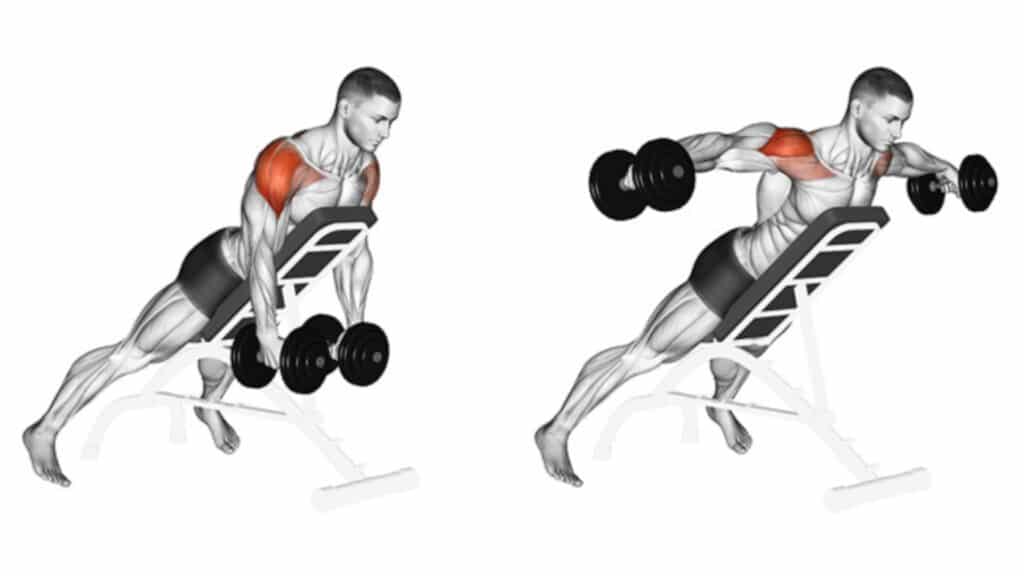
11. Dumbbell Chest Supported Lateral Raises
This exercise involves lying face down on an incline bench to support the chest.
This helps to isolate the lateral deltoid muscles and reduce the involvement of other muscle groups.
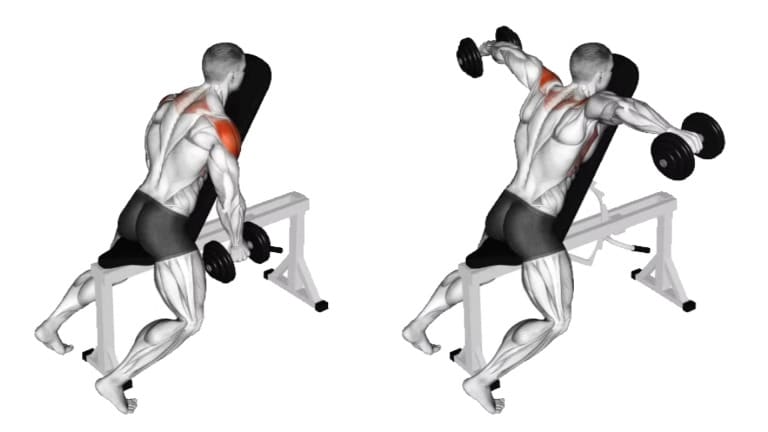
12. Standing Dumbbell Rear Delt Fly
The bent-over dumbbell reverse fly, also known as the bent-over rear delt fly, is a great exercise for building a complete set of shoulders.
Many lifters utilize the bent-over dumbbell reverse fly to target the rear delts, an often lagging muscle for many lifters alike.
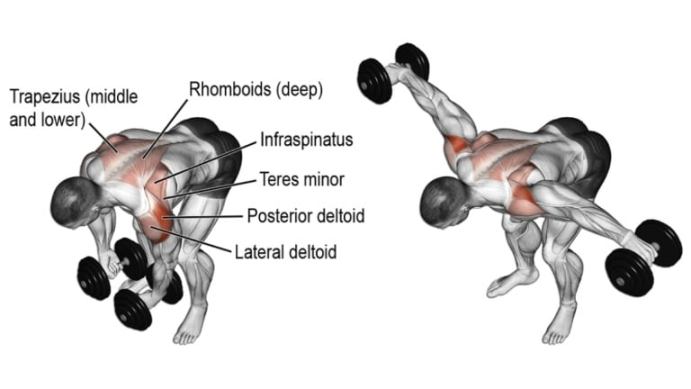
13. Dumbbell Lateral To Front Raise
The dumbbell front raise to lateral raise is an exercise that combines two exercises that build and strengthen the middle deltoids and the anterior deltoids of the shoulders.
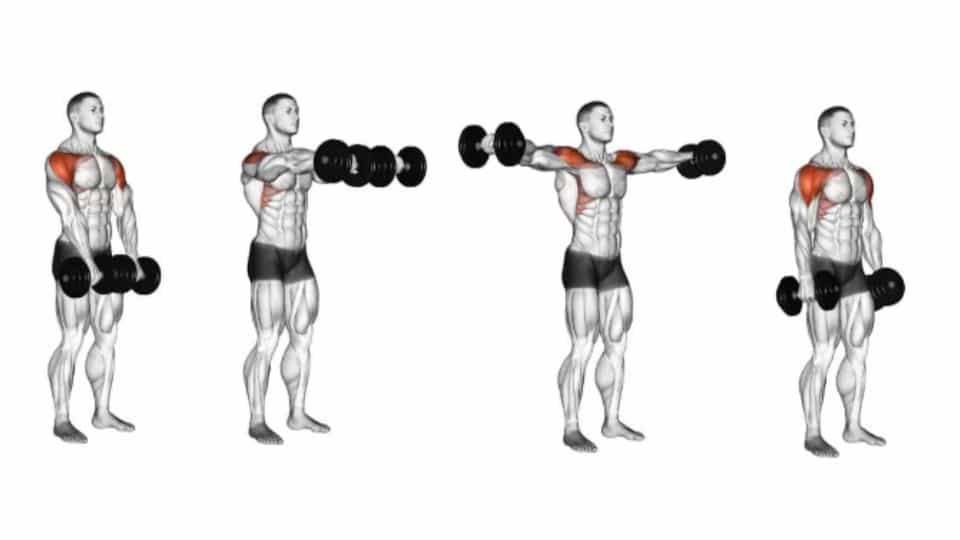
14. Seated Dumbbell Front Raise
The seated dumbbell front raise is a variation of the traditional front raise exercise, with the added benefit of increased stability and isolation of the shoulder muscles.
It is ideal for people who want to build shoulder strength without putting too much strain on other body parts.
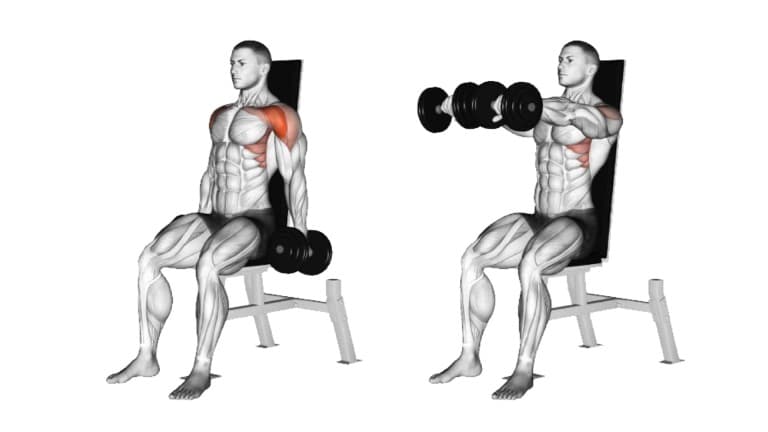
15. Dumbbell One-Arm Shoulder Press
If you’re looking for straightforward single-arm shoulder exercises to add to your routine, dumbbell one-arm shoulder press is a great staple exercise to get you started.
It is a unilateral exercise that increases shoulder strength, stability, and symmetry.
Performing the exercise with one arm at a time will actively engage the core throughout the range of motion.
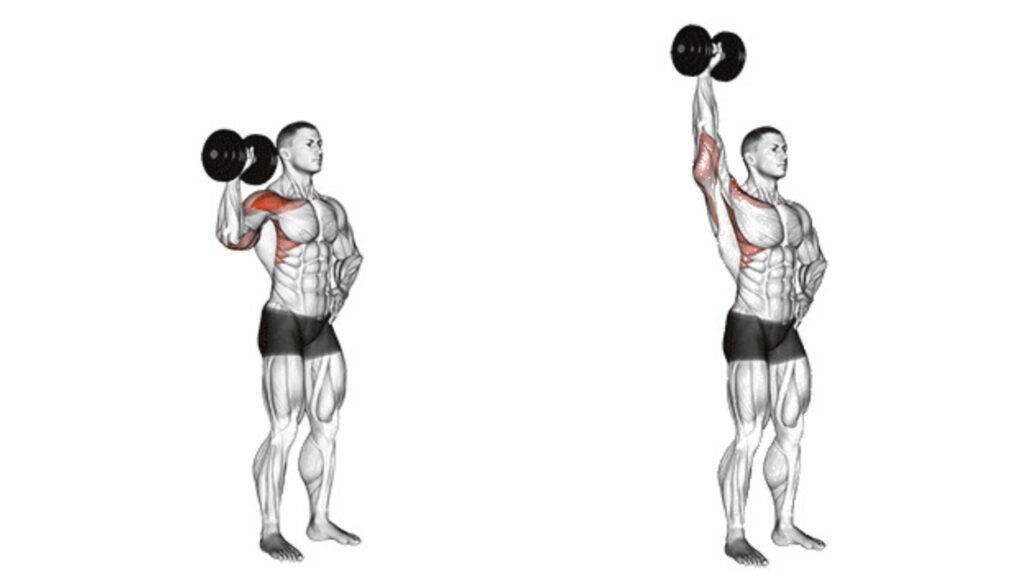
16. Side-Lying Rear Fly
The side-lying rear delt fly is an upper-back exercise that targets the rear delts and rhomboids.
It is a great unilateral exercise used to target a smaller and often lagging muscle group. Instead of lying on the floor, you can lie on a bench.
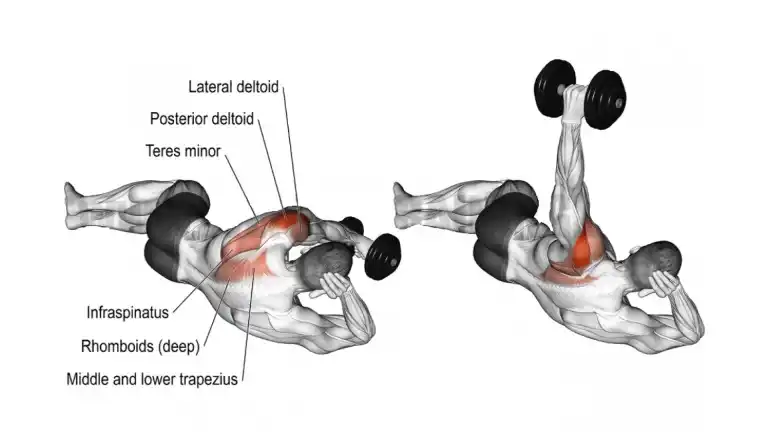
17. Leaning Dumbbell Lateral Raise
A leaning-away lateral raise is more effective than a dumbbell side raise because it puts your lateral deltoid under tension throughout a greater portion of the range of motion.
The leaning position maximizes the isolation of the shoulders throughout the movement.
It also places greater overload at the top of the movement.
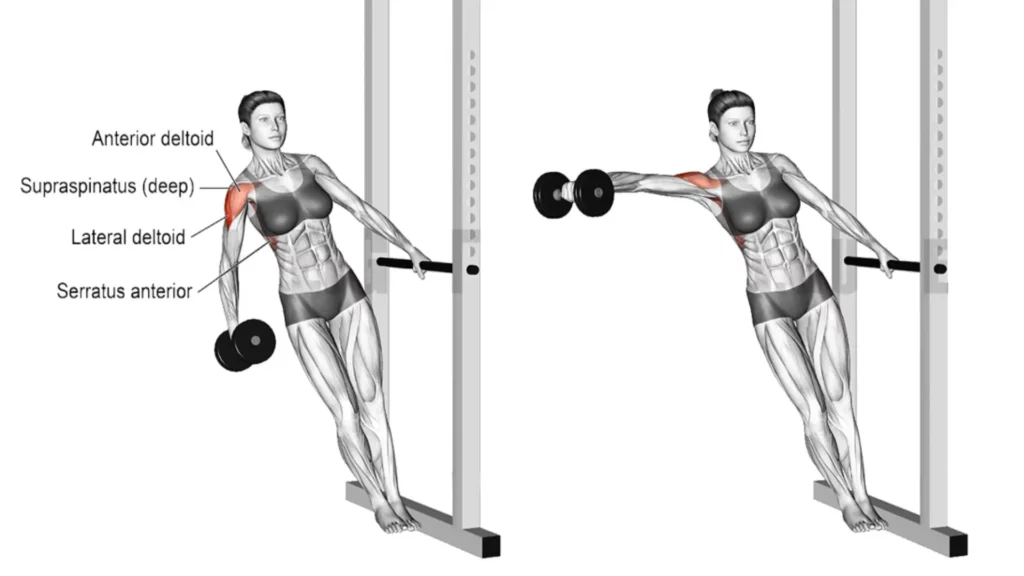
18. One-Arm Dumbbell Upright Row
This unilateral variation of the classic dumbbell upright row targets the same muscles while adding an extra element of stability and core engagement.
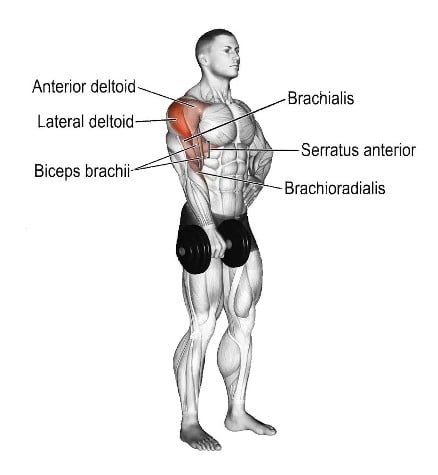
19. Incline Dumbbell Side Lateral Raise
If you’re looking for a way to get more creative with your dumbbell lateral raise, why not try an incline lateral raise?
Many movements that work the same muscle group may look alike, but they focus on different parts of the muscles because they are at various angles.
If you want to develop better muscle specifically, remember that including exercises focusing on different aspects of your training program is more beneficial.
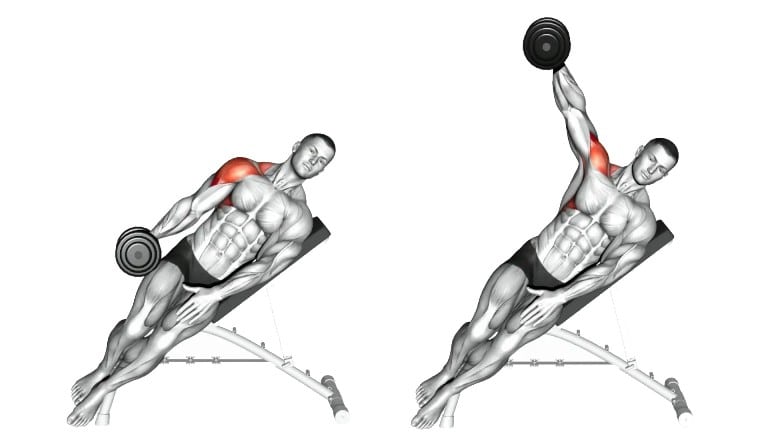
20. Chest Supported Front Raise
This exercise involves lying face down on an incline bench to support the chest.
This helps to isolate the anterior deltoid muscles and reduce the involvement of other muscle groups.
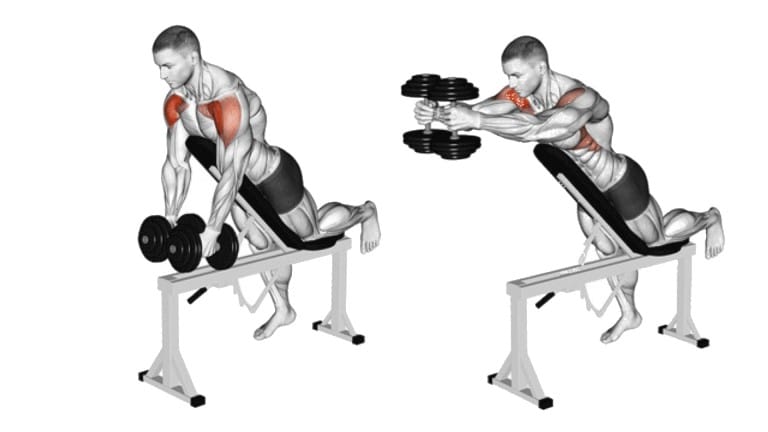
21. Head-Supported Rear Dumbbell Fly
The head-supported reverse dumbbell fly is also known as the head-supported bent-over dumbbell lateral raise.
Keep your torso horizontal to target your posterior deltoids during the head-supported reverse dumbbell fly.
The more upright your torso is, the more emphasis you will place on your lateral deltoids instead of on your posterior deltoids.
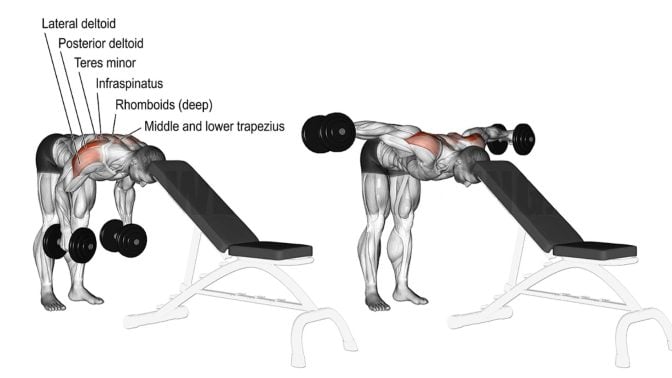
22. Incline Dumbbell Front Raise
The incline dumbbell front raise is performed face-down on an incline bench.
This changes the angle of the movement and puts more emphasis on the front deltoids and upper chest.
It also allows you to use heavier weights due to the bench’s support, while the standing dumbbell front raise requires more stability.
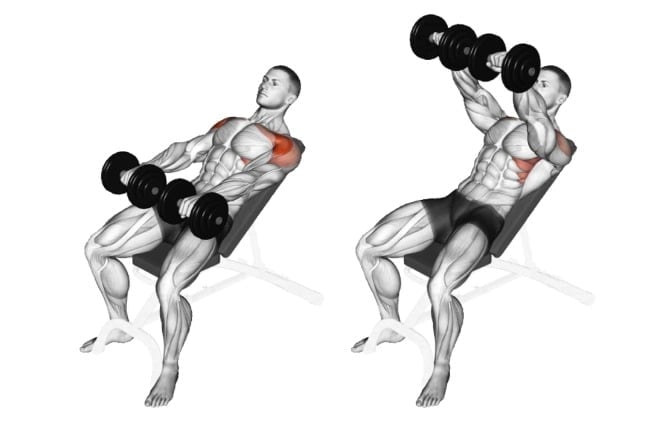
23. Neutral-Grip Dumbbell Front Raise
The dumbbell front raises with a neutral grip are a great exercise that targets the front of the shoulders.
A neutral grip on the shoulder joint will be easier when using a palm facing in.
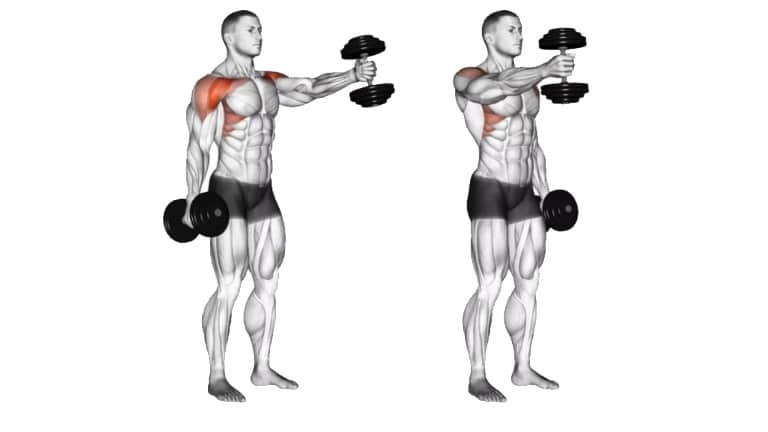
24. Dumbbell I, Y, T, W Raise
These exercises focus on the shoulder and back muscles, mainly the middle and lower part of the trapezius.
They also hit all the rotator cuff muscles, including the infraspinatus, subscapularis, teres minor, and supraspinatus muscles.
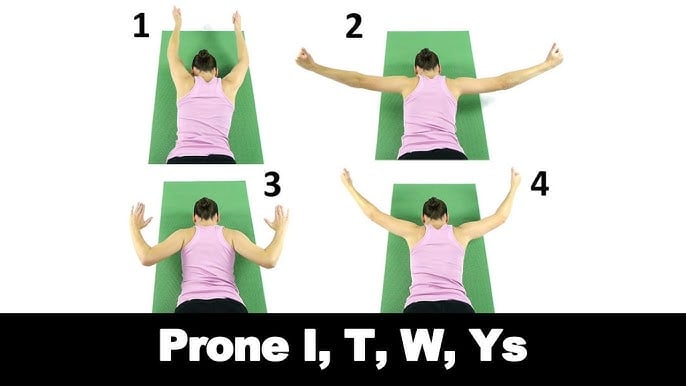
Incline Y dumbbell raises are a great and easy-to-do shoulder stability exercise that targets both the rotator cuff muscles and your mid and lower traps.
Although the Y Raise is commonly performed on an incline bench, it can be modified to suit your needs and performed standing, on the floor, flat, or even with a Swiss ball.
25. Dumbbell Cuban Press
The Dumbbell Cuban Press is a compound exercise combining an external shoulder rotation and a dumbbell press. It targets the shoulders, rotator cuff, and upper back muscles.
It is not a mass-building exercise, but is beneficial for shoulder stability, rotator cuff strength, and improved mobility.
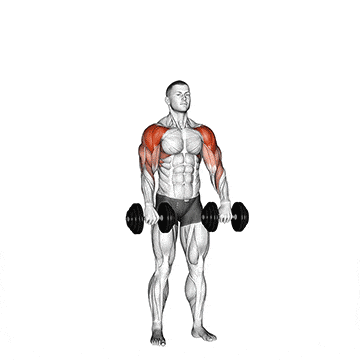
26. Dumbbell Scaption
The dumbbell scaption is a shoulder exercise that targets the middle deltoids and rotator cuff muscles.
Additionally, it helps improve shoulder mobility and can aid in posture correction by strengthening shoulder and upper back muscles.
To perform it:
- Hold a dumbbell in each hand down by your sides with palms facing inward.
- Lift the dumbbells out to the sides and upwards in a diagonal plane until shoulder height.
- Slowly lower back to the starting position.
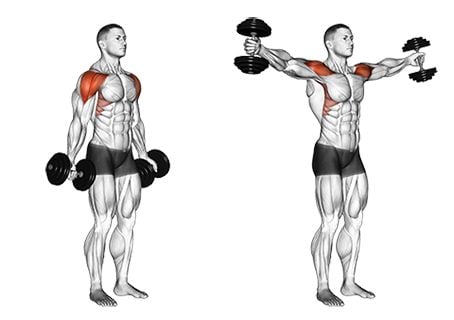
27. Dumbbell Z Press
The Dumbbell Z Press is performed while sitting on the floor with legs extended straight ahead. This exercise primarily targets the shoulder muscles (deltoids), triceps, and upper back.
The unique seated position of the Z Press eliminates leg drive and lower body involvement.
You can perform it with different leg positions (seated, kneeling, standing) and grip variations (neutral, pronated) to add challenge and target various muscle groups.

28. Dumbbell High Pull
This exercise requires coordination between different muscle groups and helps develop explosive power, which is beneficial for athletic performance.
It targets rhomboids, deltoids, latissimus dorsi, trapezius, biceps, triceps, lower back, abdominals, glutes, and hips.
How to do it:
- Stand holding two dumbbells with an overhand grip.
- Keep knees slightly bent.
- Initiate the movement by extending through the hips and knees to shrug the weights up explosively.
- Continue the momentum by pulling the dumbbells up to shoulder height.
- Slowly lower the dumbbells back down by hinging at the hips.
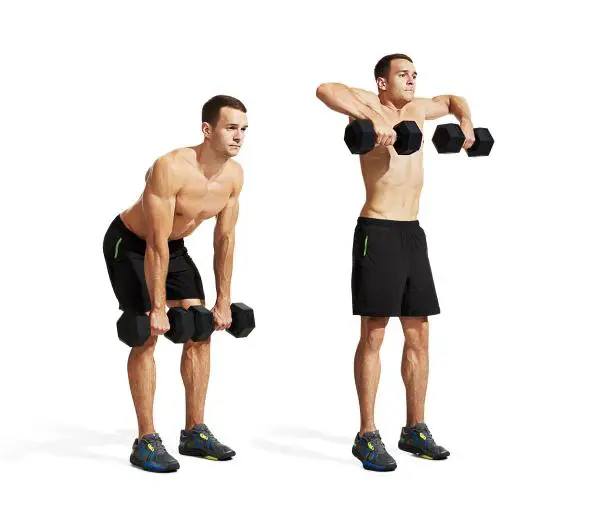
29. Dumbbell Push Press
The dumbbell push press is fantastic for building explosive power and sculpting your shoulders. It combines elements of the overhead press and the leg drive.
Its explosive nature helps burn more calories and improve cardiovascular fitness.
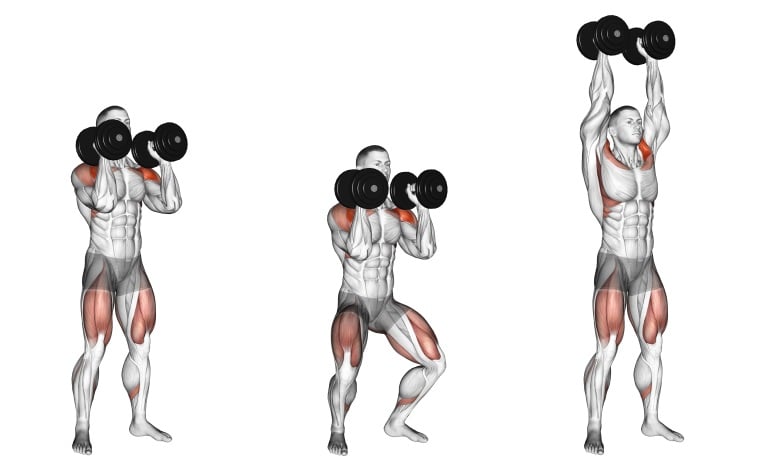
30. Dumbbell Clean and Press
The Dumbbell Clean and Press is a full-body exercise that involves lifting dumbbells from the floor to the shoulders and pressing them overhead.
It is a compound movement that engages multiple muscle groups. It is an efficient exercise for strength and power development.
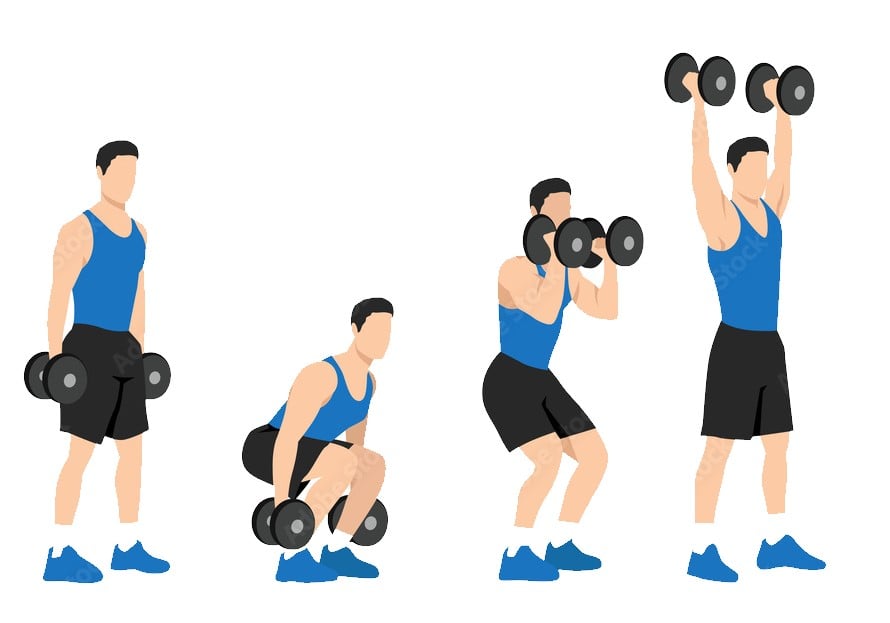
Cable Shoulder Exercise Names For Gym Workout
Cables provide constant tension through a full range of motion, allowing for focused development of the shoulders.
This section will provide over 20 cable shoulder exercises with illustrations and descriptions to build, strengthen, and shape the delts.
1. Cable Shoulder Press
It is a variation of the shoulder or overhead press, one of the best exercises for building size and strength.
Even though you might not see many people using the cable machine for shoulder presses, mixing in your shoulder workout is a fantastic exercise for extra variety.
The angle of the cable overhead press can help recruit new muscle fiber that’s not engaged much with other shoulder presses because the force is pulling down behind you.
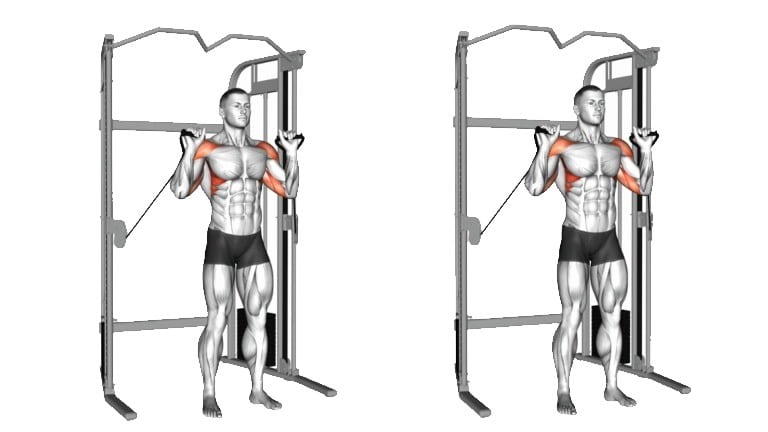
2. Cable Front Raise
The cable front raise is a cable or machine-assisted shoulder exercise focusing on the anterior deltoid.
It is an isolation exercise that athletes and regular gym goers primarily perform for improved size and strength in the anterior deltoid muscle group.
You can also perform the cable front raise using a rope attachment or a single stirrup, one arm at a time.
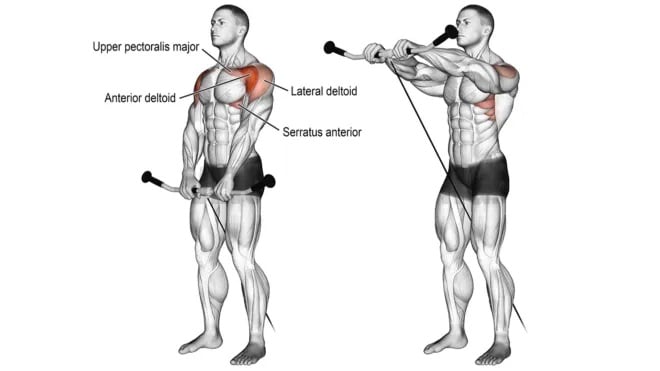
3. Single Arm Cable Front Raise
When doing a shoulder workout with a cable machine, you can add plenty of single-arm exercises to correct potential imbalances.
It is one of the most effective front raise variations that works the front deltoid muscles.
It’s a unilateral exercise, so you only work one shoulder at a time.
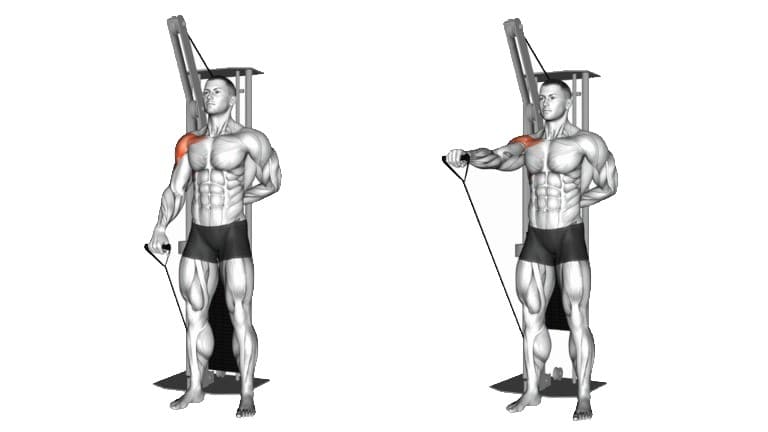
4. Cable Upright Row
Upright row activates all major shoulder muscles, making it excellent for upper body stability and conditioning. It is essential to do this regularly to improve your posture and protect yourself from injury.
Cable upright row keeps tension on the muscles throughout the entire range of motion, ultimately increasing muscle activation and hypertrophy.
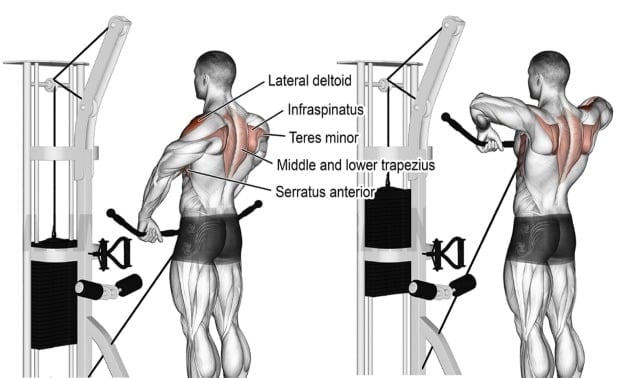
5. One Arm Cable Lateral Raise
The one-arm cable lateral raise is an isolated shoulder exercise that targets the deltoids while increasing stability in both the wrists and the core.
It works the lateral head of the deltoid muscle, which is the rounded muscle at the top of each shoulder.
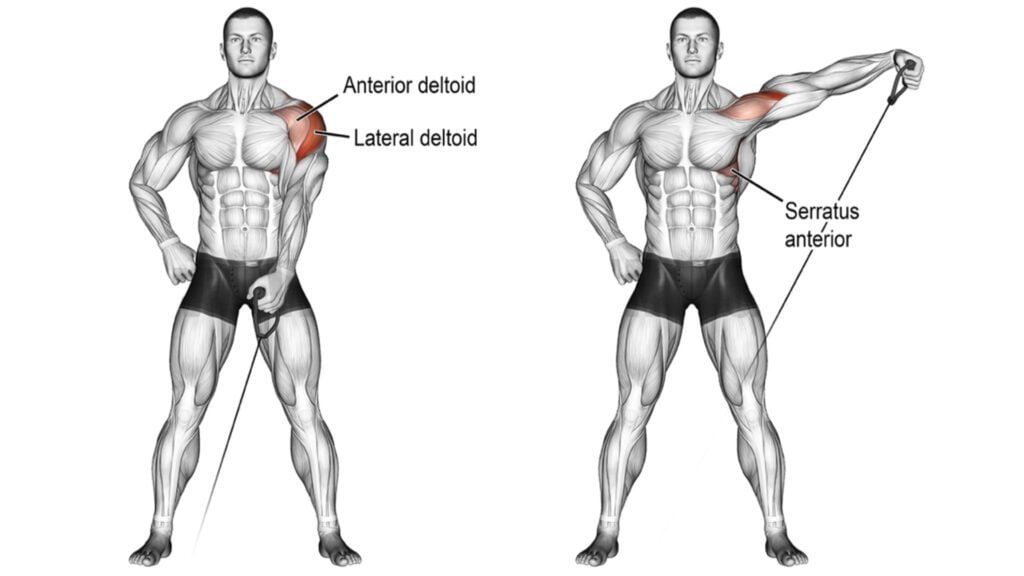
6. Cable Lateral Raise
The cable lateral raise is one of the best two-arm cable shoulder exercises for working out your side deltoid.
Multiple variations of the lateral raise exist, but they all have the same goal: to build the lateral delts.
You should begin with a lighter weight to achieve optimal performance.
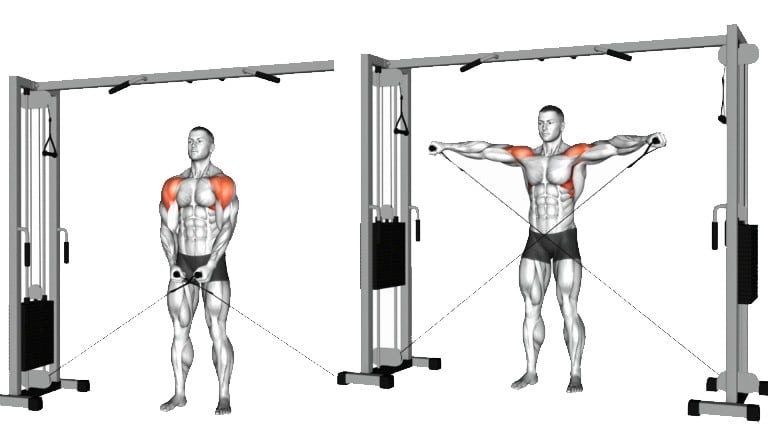
7. Cable Machine Y Raise
Cable Y-raise is a fantastic exercise for the whole shoulder (deltoid) that activates all deltoid fibers: anterior, lateral, and posterior, but it mainly targets the lateral shoulder.
This exercise combines horizontal shoulder abduction with external shoulder rotation.
It is strengthening the external shoulder rotators and the internal shoulder rotators.
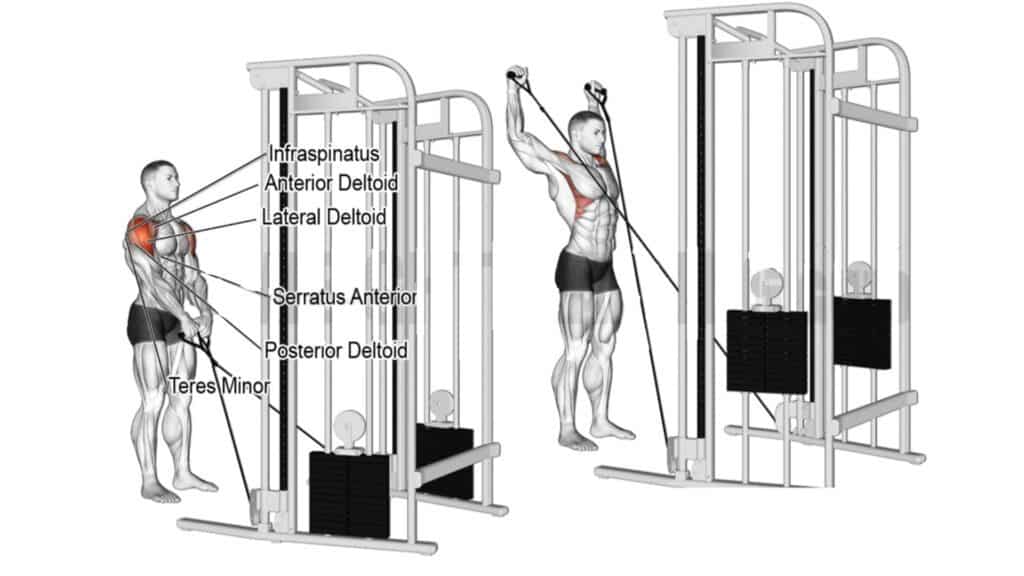
8. Bent Over Cable Lateral Raise
A bent over cable raise is an excellent exercise to train and isolate the rear deltoid muscle.
It provides constant stress on the muscles. Unlike dumbbell raises, where the resistance varies during the lift, the cable pulley affords a uniform resistance throughout the motion.
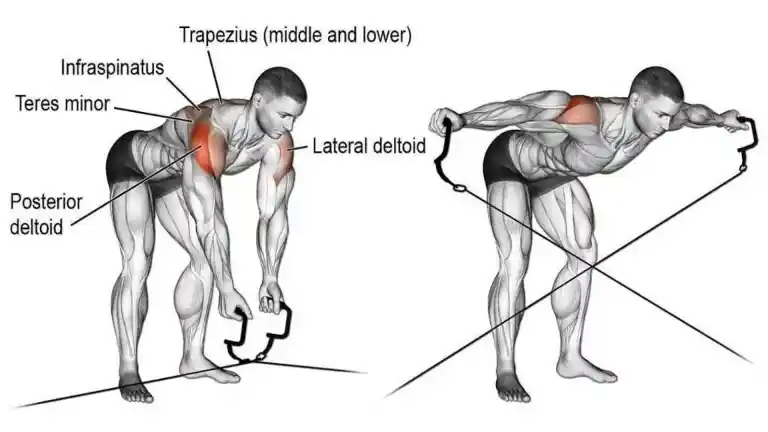
9. One-Arm Bent Over Cable Raise
You can do this exercise using one arm at a time, allowing you to alter the range of motion by adjusting the start or finish position.
This unilateral version allows you to raise your hand higher and get a longer stretch at the bottom, thereby generating more work for the posterior deltoid.
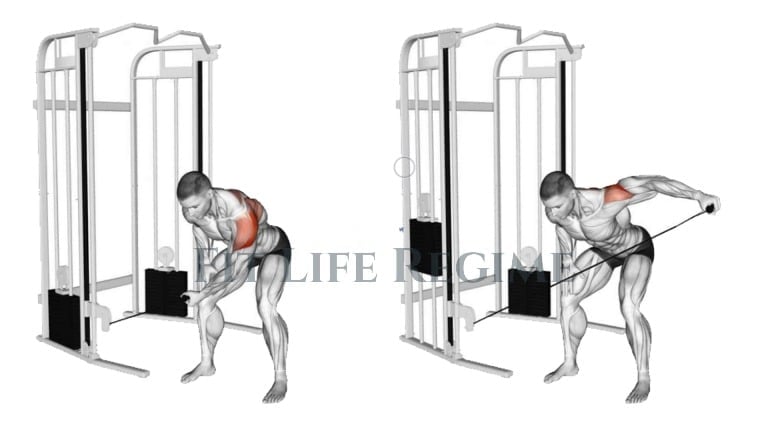
10. Reverse Cable Crossover
The Reverse Cable Crossover helps you to strengthen and tone the rear deltoid muscles.
It is a very effective and functional exercise for building muscle and strength in the posterior deltoids. Additionally, it helps to improve shoulder stability and posture.
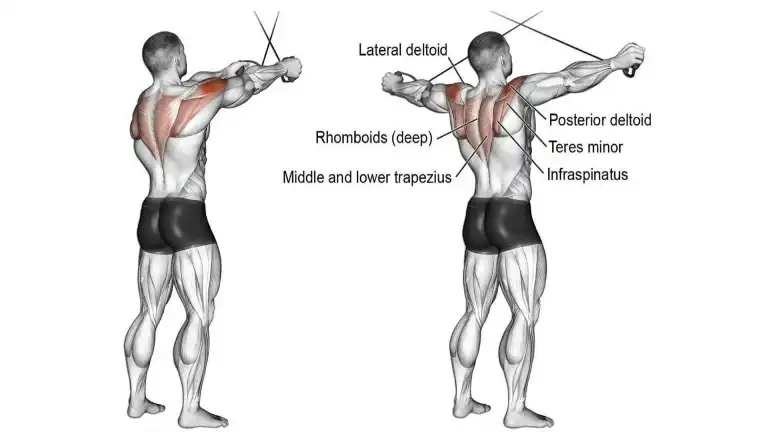
11. Lying Reverse Fly (Supine Cable Reverse Fly)
The lying reverse fly is the perfect exercise to hit the rear delts and upper back muscles.
Completing this exercise in a supine position on your back allows you to focus purely on contracting your rear delts to pull the cables down to the sides
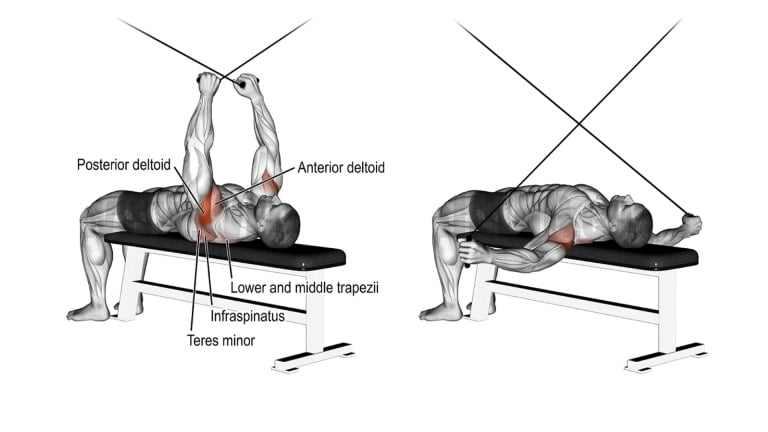
12. Cable Twisting Overhead Press
The cable twisting overhead press is another effective single-arm cable shoulder exercise. It is a very effective shoulder press variation that works the anterior delt.
It’s a pretty simple exercise, and anyone can do it effectively, making it ideal for size and strength gains.
It is brilliant for developing unilateral upper-body strength, improving balance, and strengthening and stabilising the core.
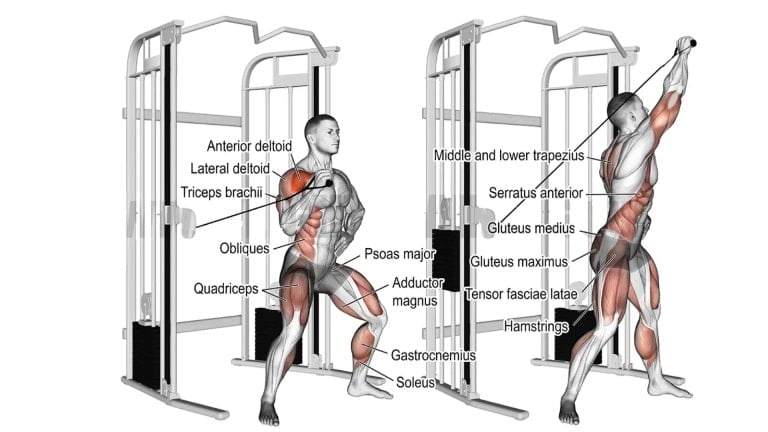
13. Face Pull
Face pull is a cable machine exercise that primarily targets the rear deltoid and, to a lesser degree, also targets the trap, biceps, and triceps.
Use a cable pulley machine to pull the weight straight toward your forehead. This exercise prevents muscular imbalance and builds overall shoulder strength.
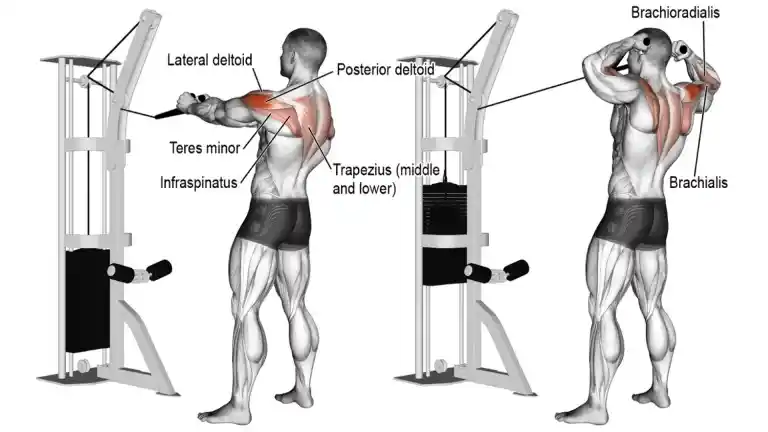
14. Cable Shrug
The cable shrug is a variation of the shoulder shrug and one of the best upper trap cable exercises to build the upper back’s trapezius muscle.
Cable machine shrug, one of the best exercises for isolating the traps, offers versatility to improve development further.
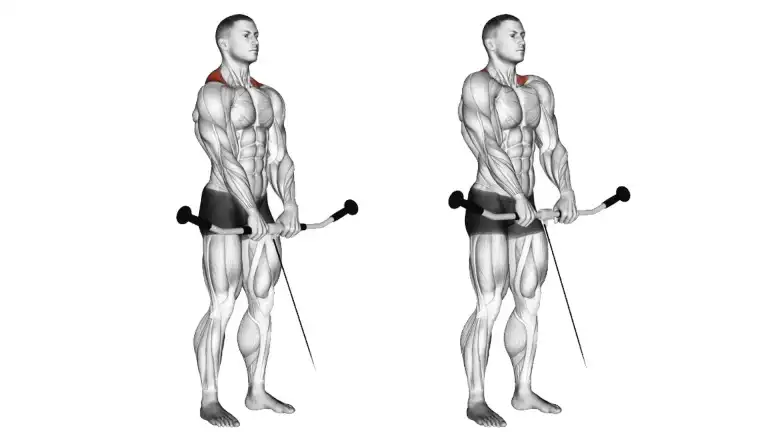
15. Cable High Row
Half kneeling high cable row rope is a tremendous exercise that effectively works many muscles, including the shoulder, back, wing, and trapezius muscles.
This exercise gives people with shoulder issues an exercise to benefit from rows.

16. Cable Rear Delt Row
When you do the cable rear delt row, ensure your elbows are not dropping.
If your elbows drop, your latissimus dorsi muscles can engage more, making the exercise more like a standard wide-grip cable row.
Since you’re working your rear deltoid with the cable delt row and not your larger latissimus dorsi, use a lighter weight than you would with the wide-grip cable row.
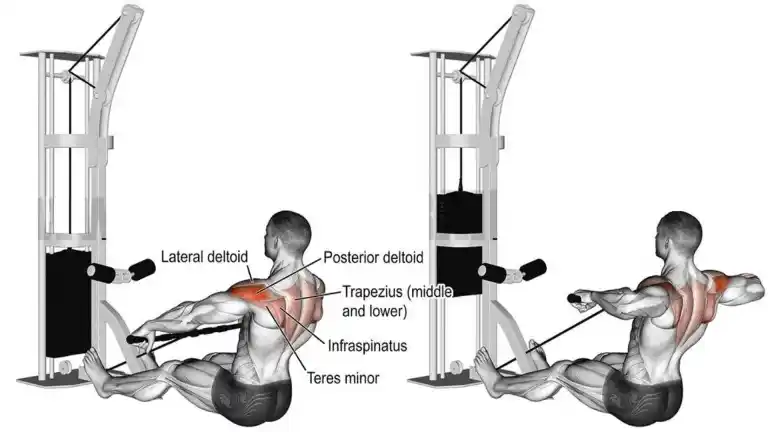
17. Alternating Cable Shoulder Press
The alternating cable overhead press can be performed in numerous ways, you could do on arm at a time if you only have one cable tower available.
Alternatively, you could do two cables, pressing up with a neutral grip to target the front delts and triceps more.
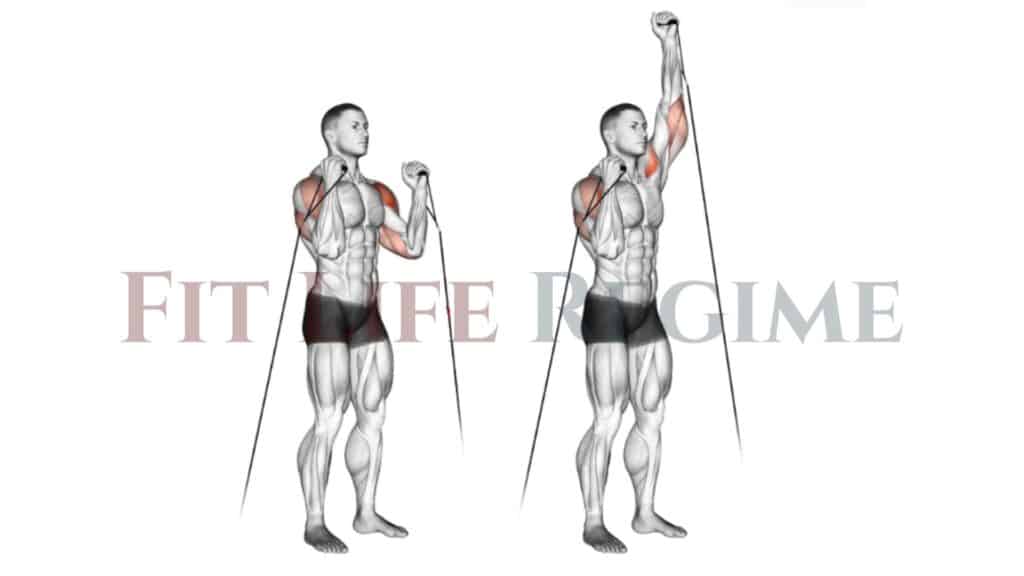
18. Standing Cable Rear Delt Row With Rope
The standing cable rear delt row with rope is an efficient and functional exercise for building muscle and strength in the posterior deltoids. This movement also hits the traps, rhomboids, and biceps.
It is usually performed for moderate to high reps, at least 8-12 reps per set, as part of an upper-body or shoulder-focused workout.

19. Cable External Rotation
The cable external rotation primarily targets the rotator cuff muscles in the shoulder, specifically the infraspinatus and teres minor. This exercise is crucial for shoulder stability and health.
Regularly performing external rotations can help prevent shoulder injuries, especially in sports or activities that involve repetitive overhead motions.
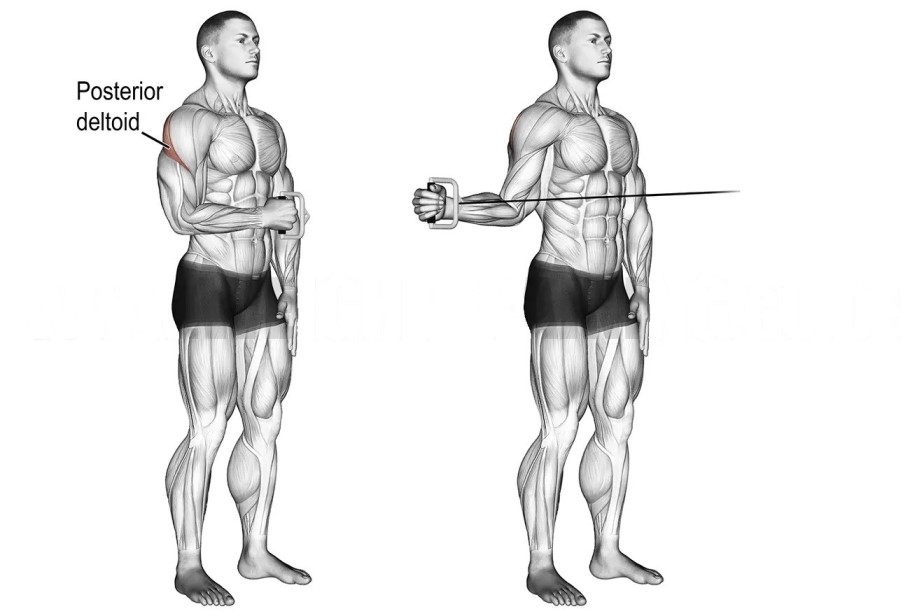
20. Cable Internal Rotation
The Cable Internal Rotation is a strength exercise that targets the rotator cuff muscles and helps to improve shoulder stability, mobility, and strength.
Strengthening the rotator cuff contributes to better overall shoulder mechanics and function.
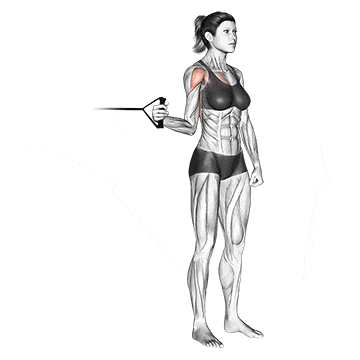
GYM Machine Shoulder Exercises With Names
Machines provide stabilized forms of resistance to isolate the shoulder muscles through fixed planes of motion. This allows for heavier lifting with less risk of injury.
This list will explain over 10 popular machine shoulder exercises paired with names, descriptions, and illustrations.
You’ll learn how to perform the machine shoulder press, lateral raise machine, front raise machine, and more with proper form to maximize size and definition gains.
1. Shoulder Press Machine
This machine is specifically designed to target the shoulder muscles, as it provides a controlled environment for overhead pressing movements. The shoulder machine press is excellent for building the front and side deltoid muscles.
Machine presses have advantages over free-weight presses, providing better stability and safety.
They also offer a choice of handgrips. A neutral grip (palms facing together) focuses more on the anterior deltoid better than a pronated grip (palms forward)
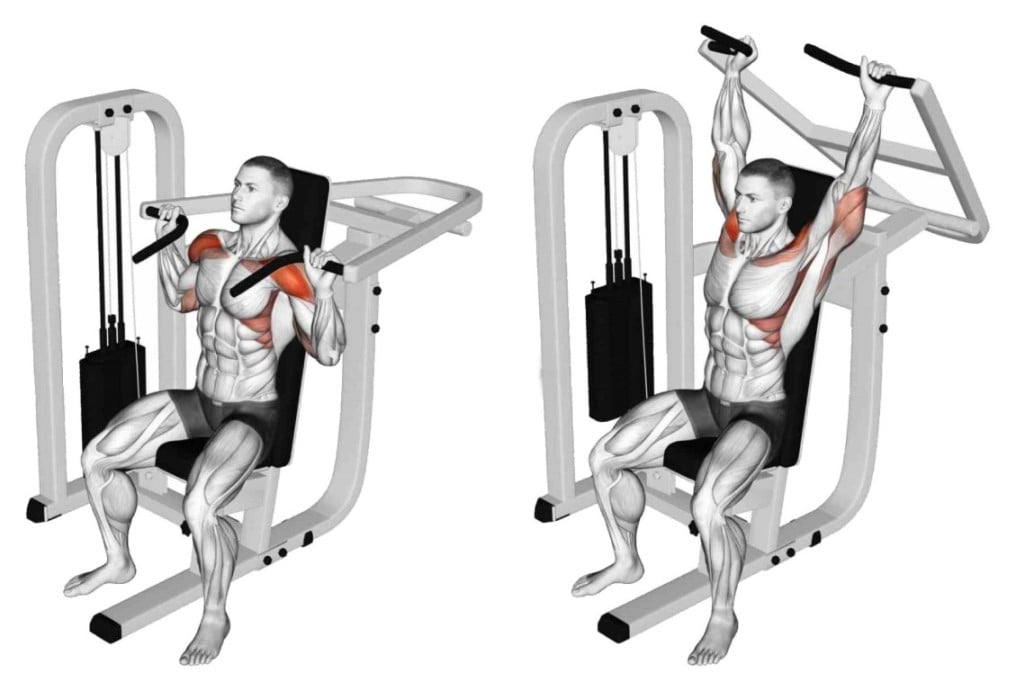
2. Smith Machine Seated Shoulder Press
The Smith machine seated shoulder press has been the favourite shoulder exercise with bodybuilders as it builds muscle fast and is a powerful move.
Upright pressing strengthens the shoulder muscles, specifically the front part of the shoulder (anterior deltoid), but you will also use some lateral delts and traps.
With the Smith machine shoulder press, you can isolate the front delt more because you don’t have to balance the bar.
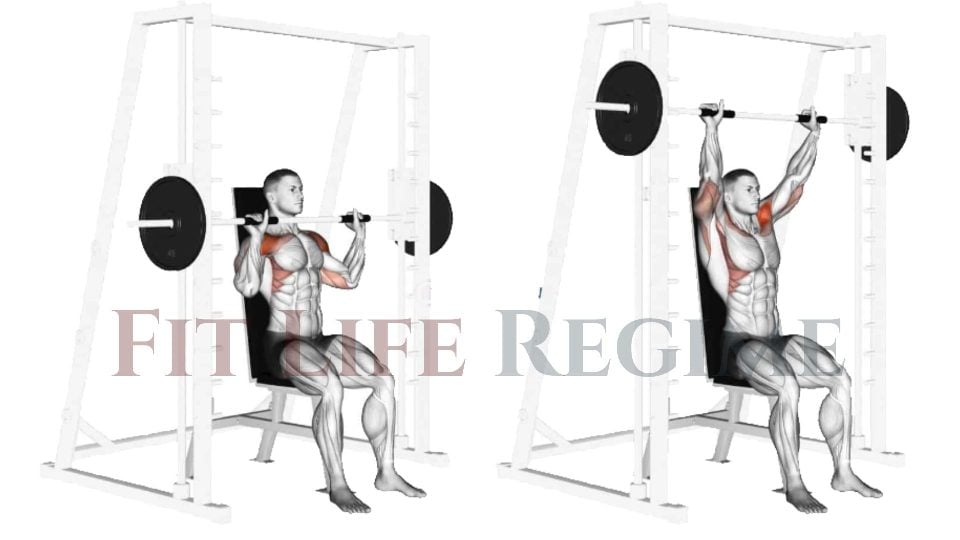
3. Reverse Machine Fly
The Pec Deck Machine is traditionally used for chest exercises, but can be adapted for a Reverse Fly to target your upper back and shoulder muscles.
This is a simple yet effective exercise that increases deltoid muscle definition and strength.
The pec deck rear delt machine fly targets your upper back muscles and shoulder muscles, particularly the rear deltoids (backside of your shoulders), Traps, and rhomboids.
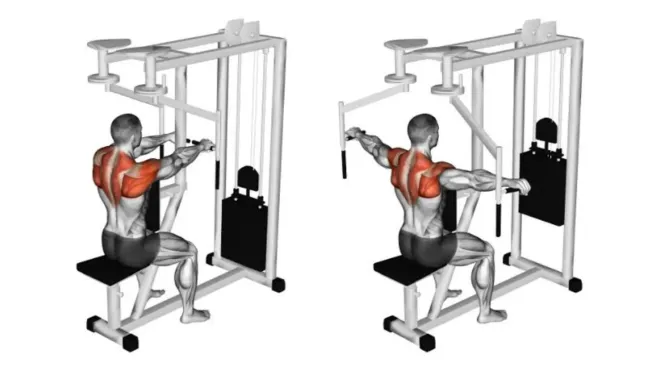
4. Smith Machine Upright Row
The Smith machine upright row is a variation of the upright row that works the shoulder and upper back muscles, including building stronger and bigger traps, rhomboids and deltoids.
Research shows that the upright row is one of the best exercises for building shoulder strength and stability.
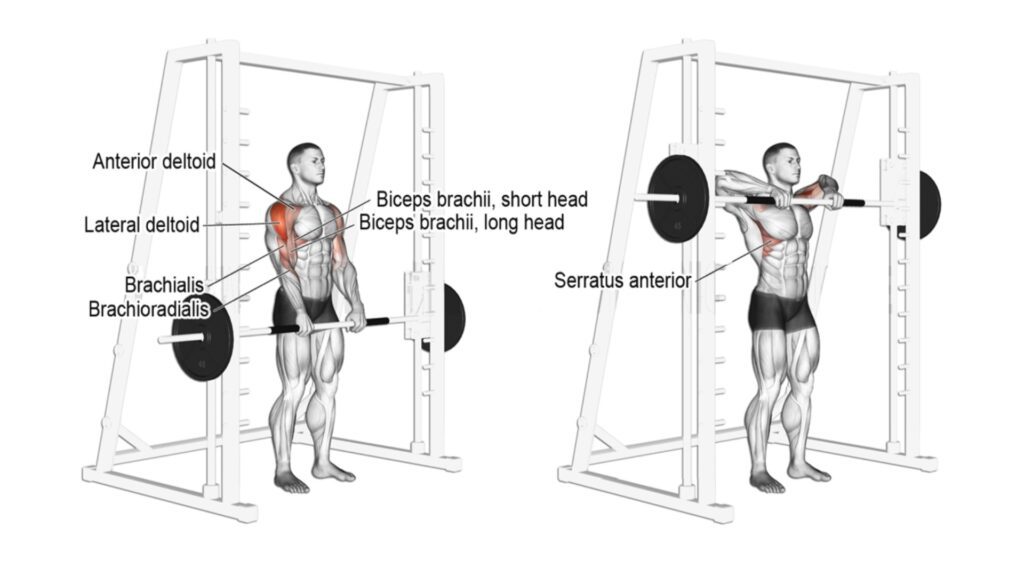
5. Machine Lateral Raise
The Lateral Raise Machine is a unique gym equipment that helps isolate the deltoid muscles, mainly the side delt. The range of motion is controlled, so you can target these muscles without working other muscle groups.
It allows for a safer and more stable workout experience. The exercise helps build shoulder strength and mass, improve mobility and flexibility, and strengthen the upper back.
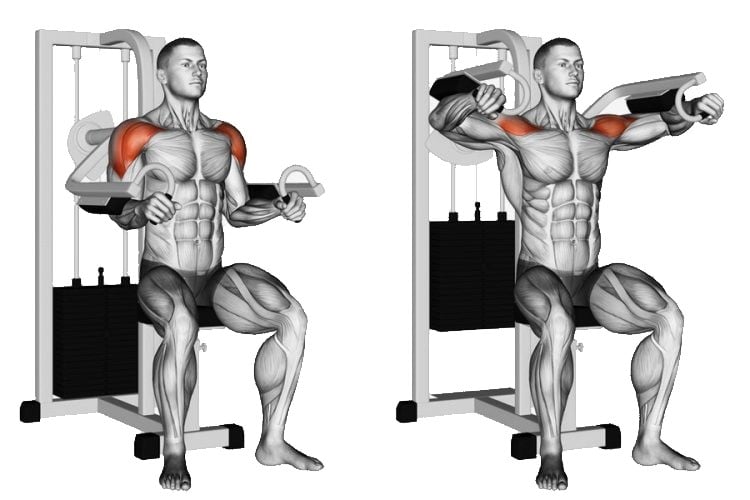
6. Smith Machine Shrug
The Smith machine shrug is perhaps the go-to movement to tone or add mass to the trapezius muscle, specifically the upper traps.
The Smith machine offers the advantage of providing stability and control during the exercise.
It allows you to focus on strengthening the trap muscles without worrying about balance or keeping the weight stable.
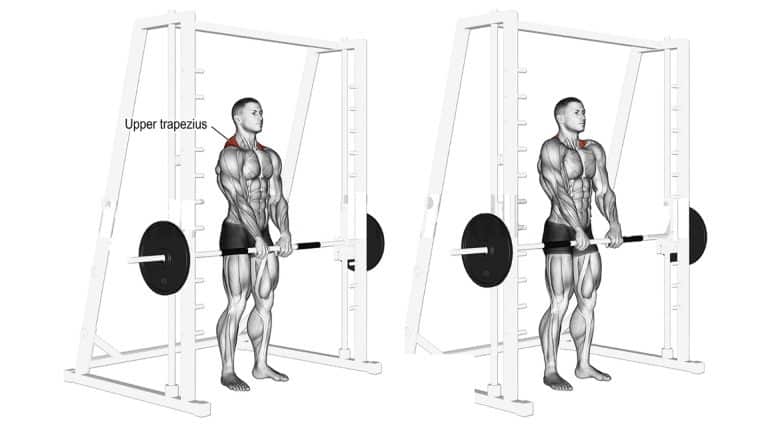
7. Smith Machine Behind The Neck Shoulder Press
A smith behind-the-neck press targets your shoulders. The standard military press and the overhead dumbbell presses hit more of the anterior head of the deltoid, which is often stimulated heavily, even during the bench press.
On the other hand, the behind-the-neck press stimulates all three heads of the shoulder and recruits the triceps, traps, and rhomboids.
If you do not have a fair amount of shoulder mobility, it is not recommended to perform it.
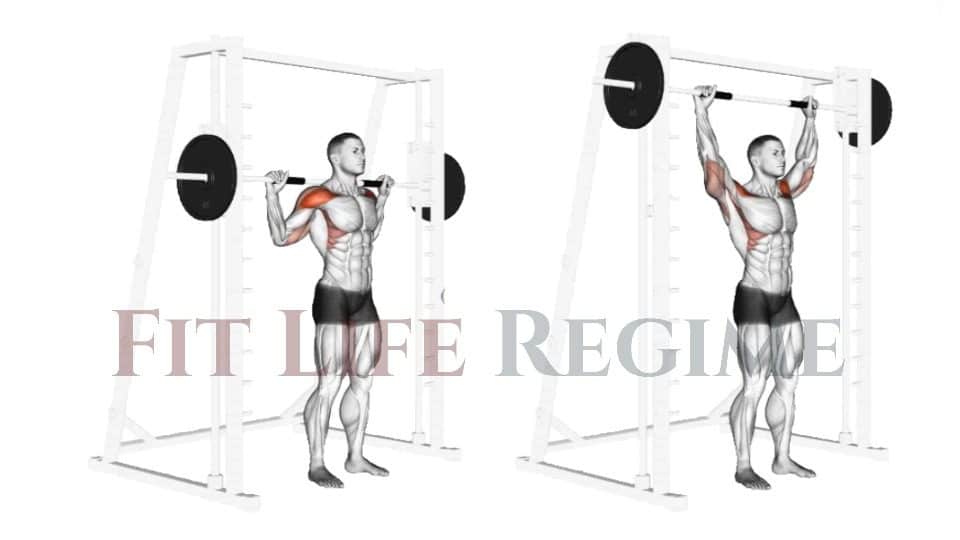
8. Shrug Machine
The Shrug Machine, also called the Trap Machine, is the best piece of gym equipment for making shrugs easier and more effective.
Unlike dumbbells or barbells, the Shrug Machine targets the upper trapezius muscles and minimizes the involvement of other muscle groups.
It has an ergonomic design lets you focus on targeting the trapezius muscles.
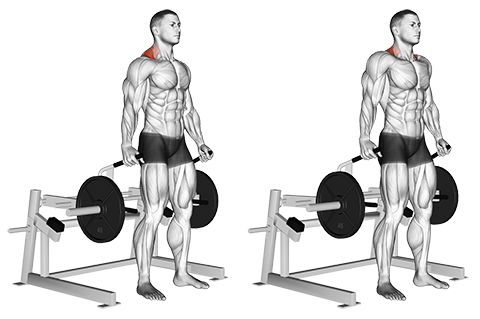
9. Rowing
The Rowing Machine, often referred to as a “rower,” is gym equipment designed to simulate the action of rowing a boat.
It is an excellent cardiovascular conditioning tool that provides substantial muscular engagement across various body parts.
Rowing machines are an all-in-one solution for burning calories, improving cardiovascular health, or gaining strength.
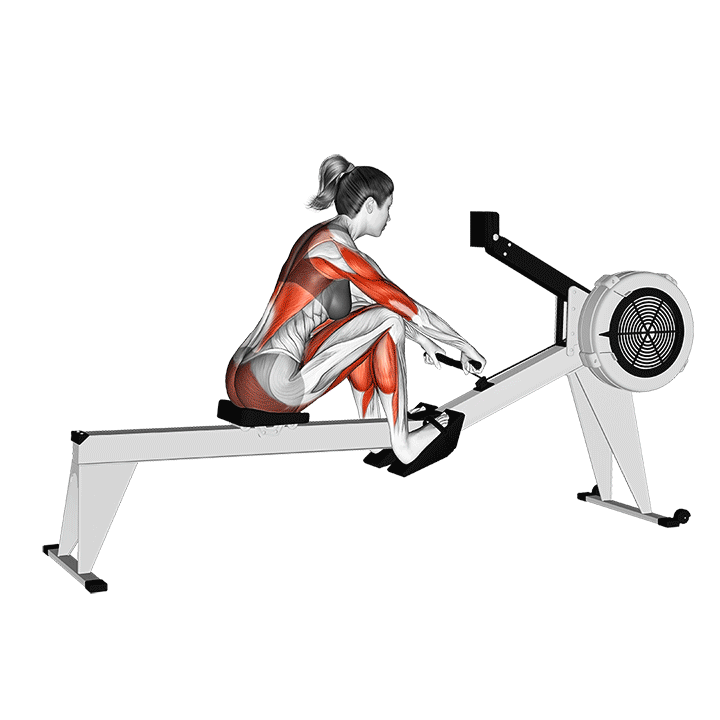
10. Behind The Back Smith Machine Shrug
Behind the back, the Smith Machine Shrug is a variation of the Smith Machine shrug.
It is usually performed for moderate to high reps, such as 8-12 reps per set or more, as part of shoulder or trap-focused training.
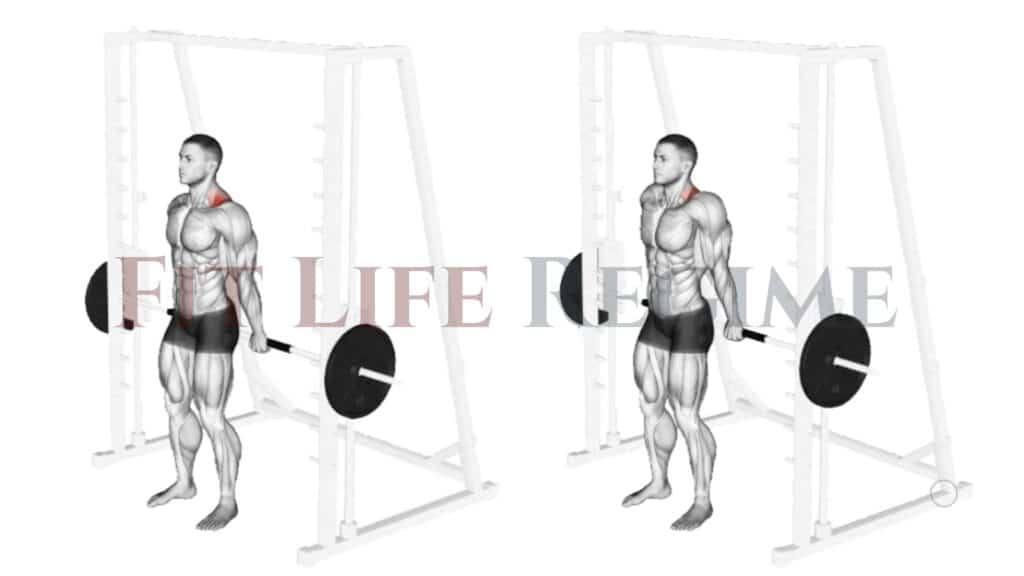
Name Of Bodyweight Shoulder Exercises
Bodyweight training helps build strong, muscular shoulders through challenging exercises that use your weight as resistance. With calisthenics, good form is important for building the mind-muscle connection for muscle growth.
This glossary will overview popular bodyweight shoulder moves, such as handstand push-ups, pike push-ups, shoulder taps, and arm circles.
Let’s build stronger shoulders with no equipment required!
1. Pike Push Up
Pike Push-ups, aka shoulder push-ups, are variations of the push-up that increase strength and stability in the shoulders and triceps.
Performing the exercise more uprightly will target the shoulders more than the chest.
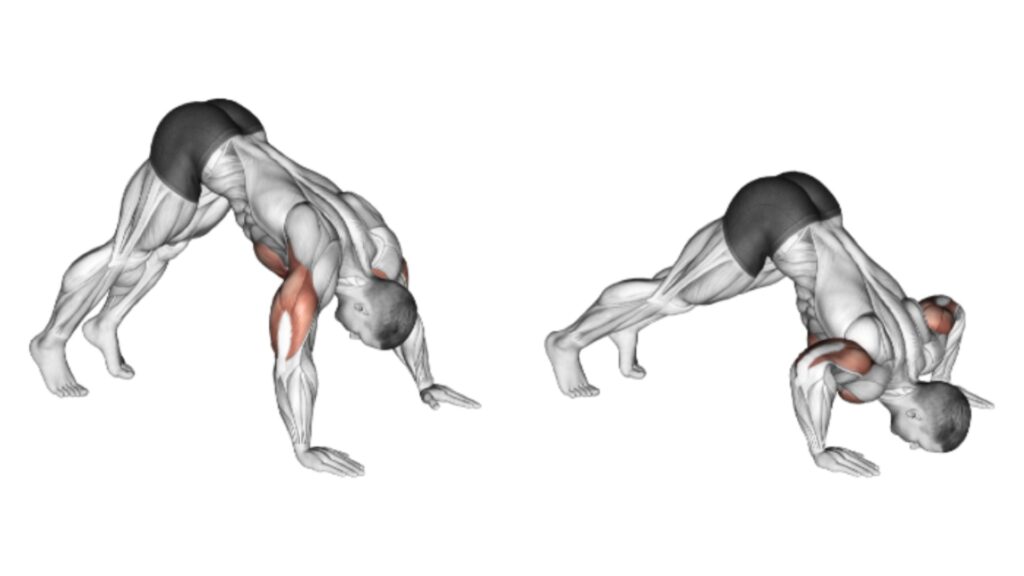
2. Incline Push-Ups
Incline push-ups are a variation of the traditional push-up exercise that targets the shoulders, chest, and triceps.
They are a great option for individuals looking to progress from knee or wall push-ups.
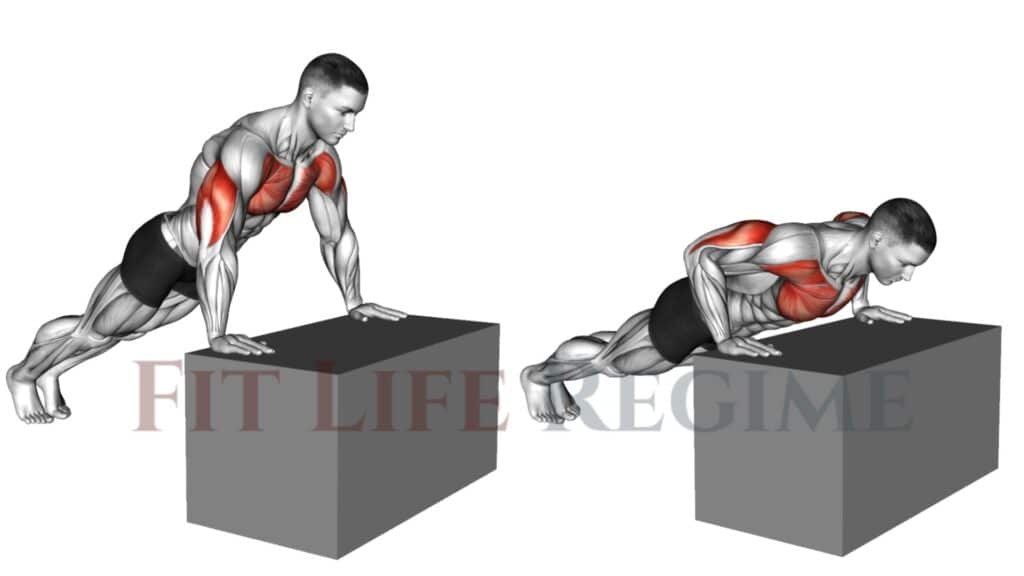
3. Side Plank
The side plank is one of the best bodyweight exercises for strengthening the core and shoulder muscles.
It is a great exercise for building stability and strength in these areas.
To make the exercise more challenging, you can add a leg lift by raising the top leg towards the ceiling while holding the side plank position
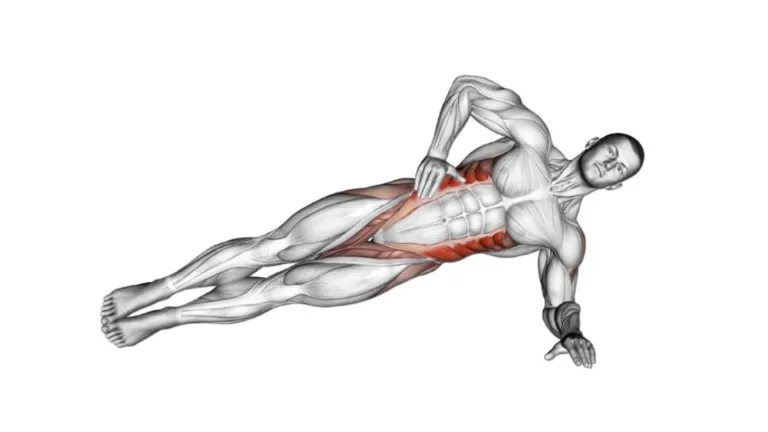
4. Bird Dog Exercise
The bird dog is a bodyweight exercise that looks elegant and very effective for training the abs muscles, lower back, and shoulder muscles.
Several other muscles are also addressed, including the glutes and hamstring.
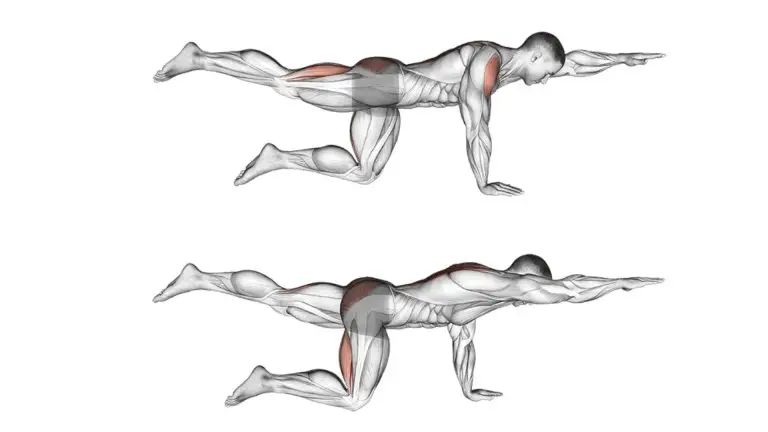
5. Plank To Push-Up
The plank to push-up is great for building upper body strength and endurance. It also works the core and improves stability.
It combines the traditional plank exercise with the push-up exercise to create a more challenging shoulder workout.
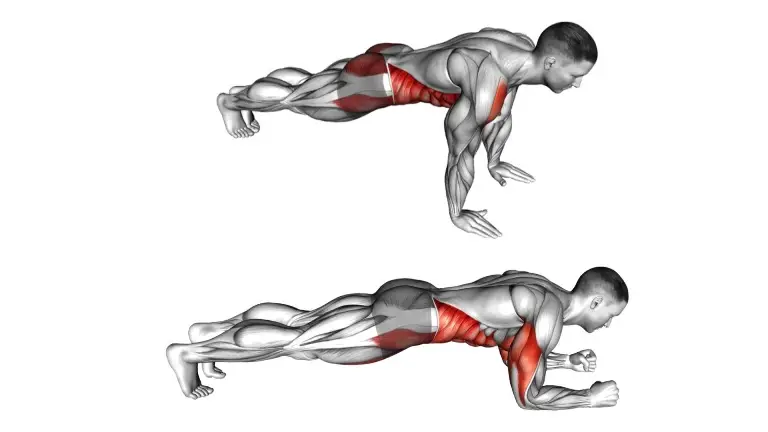
6. Tabletop Reverse Pike
Table-top reverses pike targets and trains your arms, shoulders, and core, improving your overall strength and stability.
This exercise also engages your glutes and legs.
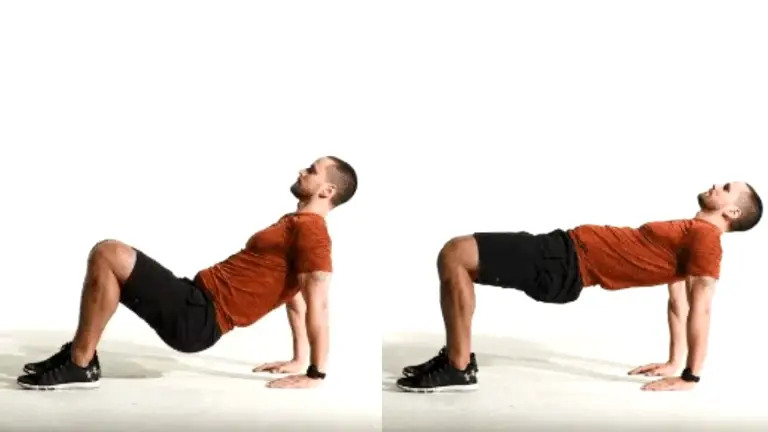
7. Crab Walk
The Crab walk is an excellent bodyweight exercise that particularly works the upper arms, shoulders, legs, and core.
It is excellent for toning, effectively targeting all your muscle groups, and working them hard to build strength.
Moves like the crab walk are great total-body exercises that don’t require additional equipment.
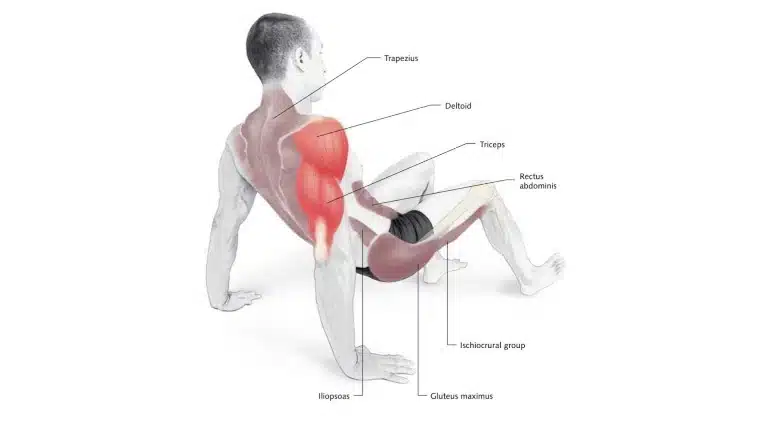
8. Hindu Push Up
The Hindu push-up, also known as a “Dhand”, is a bodyweight exercise that targets the shoulders, chest, triceps, and core and back muscles.
It is a dynamic exercise combining yoga and traditional push-ups to create a more challenging shoulder workout.
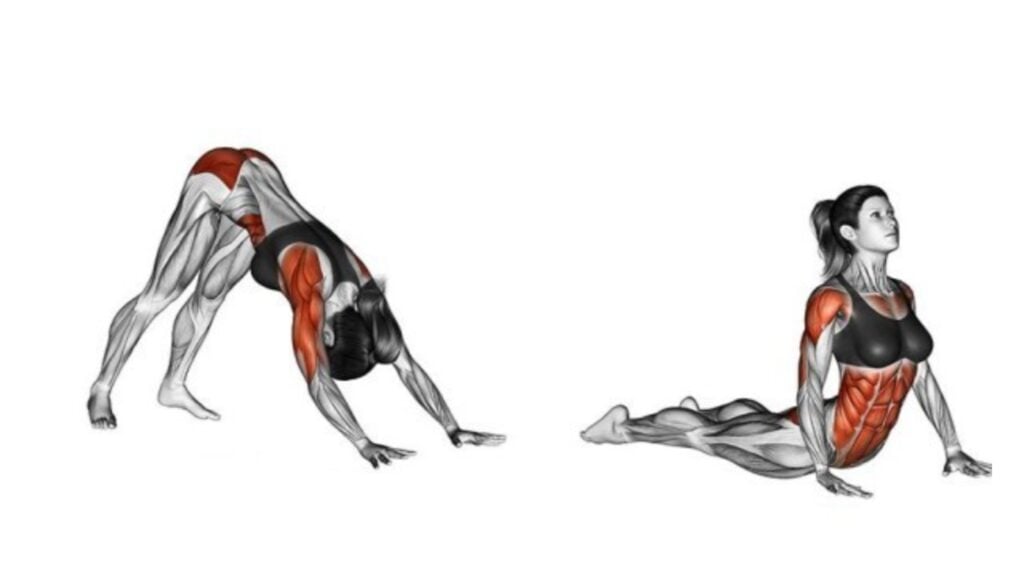
9. Archer Push-Up
In Archer push-up, the arms are kept wider than the normal push-up position and as you lower your body, you transfer most of your weight to one of your hands and incline towards that hand while the other is kept straight.
Simultaneously, move your body to both sides. You must maintain a tight, steady, and controlled body for an Archer push-up.

10. Shoulder Tap Push Up
Shoulder Tap Push-Up is a full-body strength move that focuses on your arms, shoulder, and chest while also strengthening your core.
It can be challenging, especially if you’re new to them. To make them easier, you can do them on your knees instead of your toes.
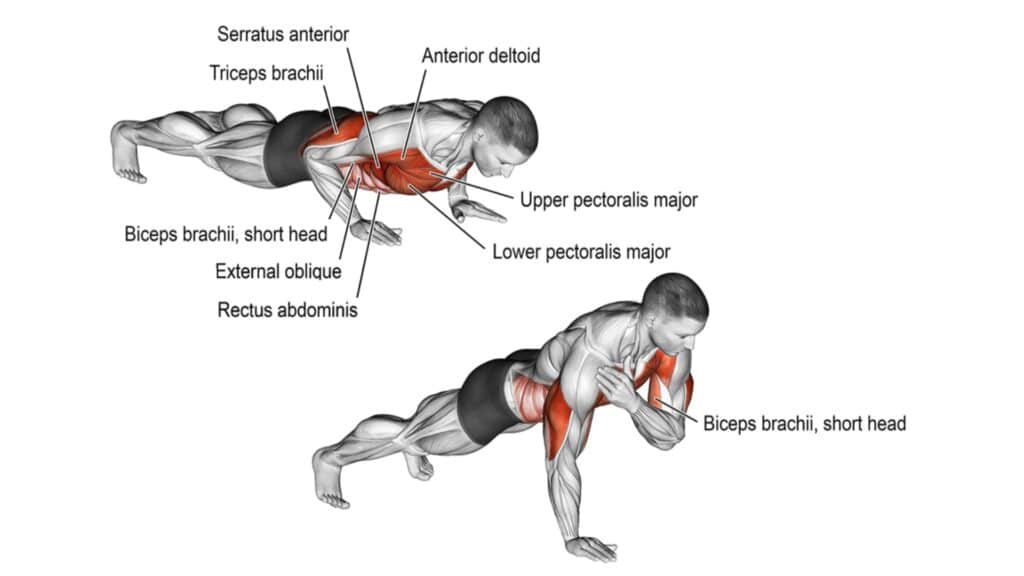
11. Stability Ball Push Up
Using an exercise ball gives you an uneven surface, increasing the difficulty of the exercise. This helps to involve the shoulder and triceps more.
You’ll have to focus on maintaining your balance on the ball, which allows you to work more.
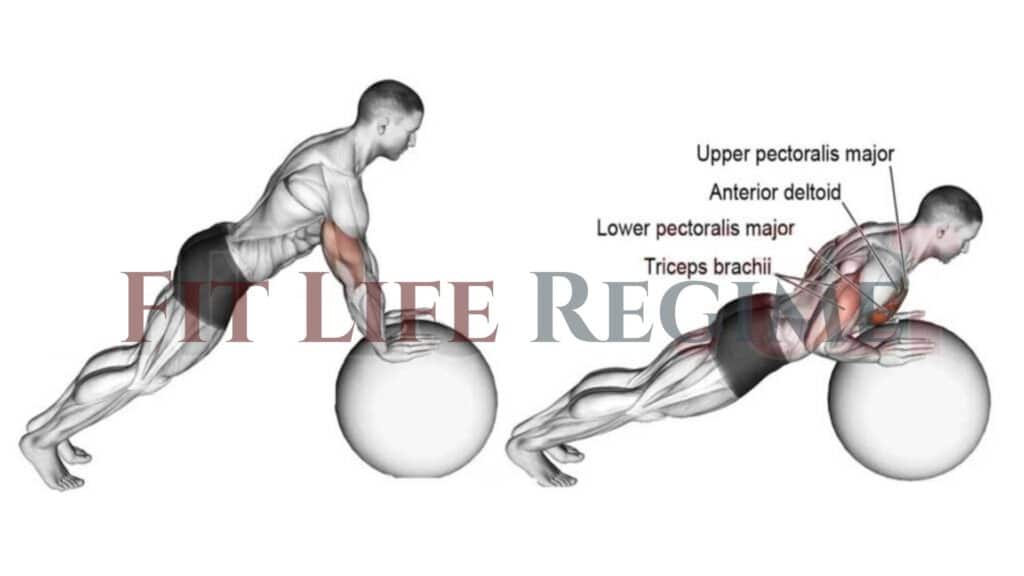
12. High Reverse Plank
The reverse plank exercise is a great bodyweight exercise for strengthening your core and the key muscles of your posterior chain, namely, your erector spinae, gluteus maximus, and hamstrings.

13. Inverted Row
The inverted row is another name for bodyweight rows.
The inverted row puts your body horizontally, making it easier to perform.
It also works the back and shoulder muscles from a different angle and improves scapular retraction.
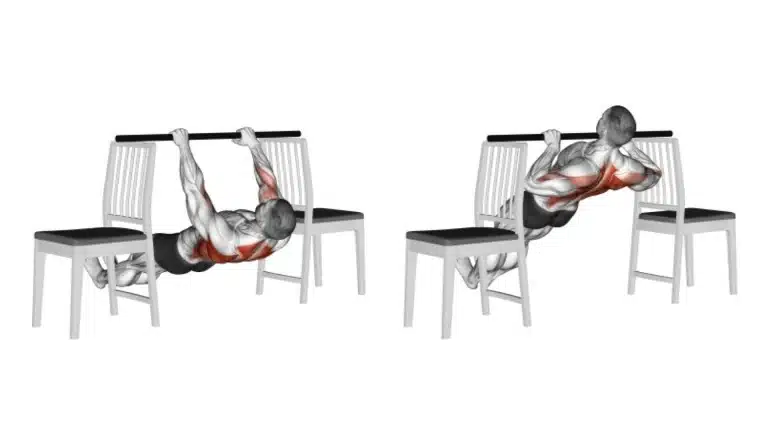
14. Clapping Push-Up
Clapping Push-ups is an advanced bodyweight exercise that works your chest, triceps, abs, and shoulders.
This type of push-up adds a “jumping” element to the exercise to make it more challenging and explosive.
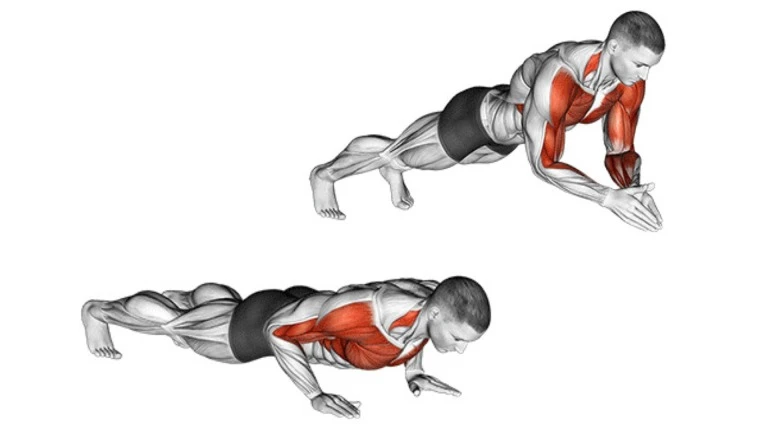
15. Elevated Pike Push-Up
The elevated pike push-up is a great exercise for building upper body strength, especially in the shoulders and triceps.
The elevated position also increases the demand on the core muscles, making it a great exercise for targeting the core as well.
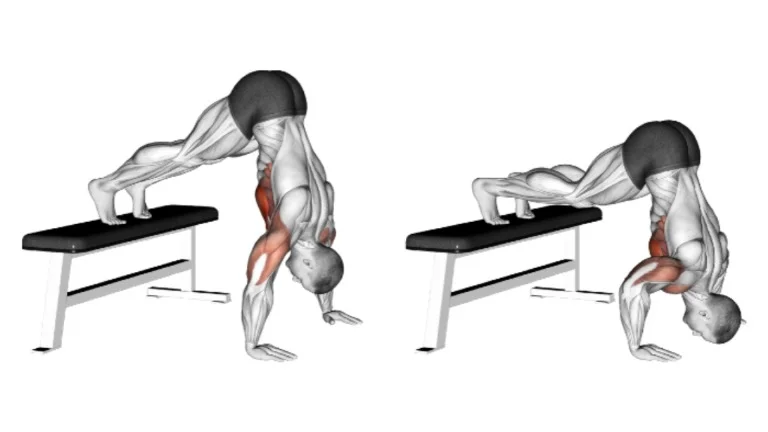
16. Handstand Push Up
The handstand push-up, also called the vertical push-up, is a type of push-up exercise where the body is positioned in a handstand.
It is an advanced bodyweight exercise that targets the shoulders, arms, and core.
They require high upper-body strength and skill and should be attempted only after proper training and conditioning.
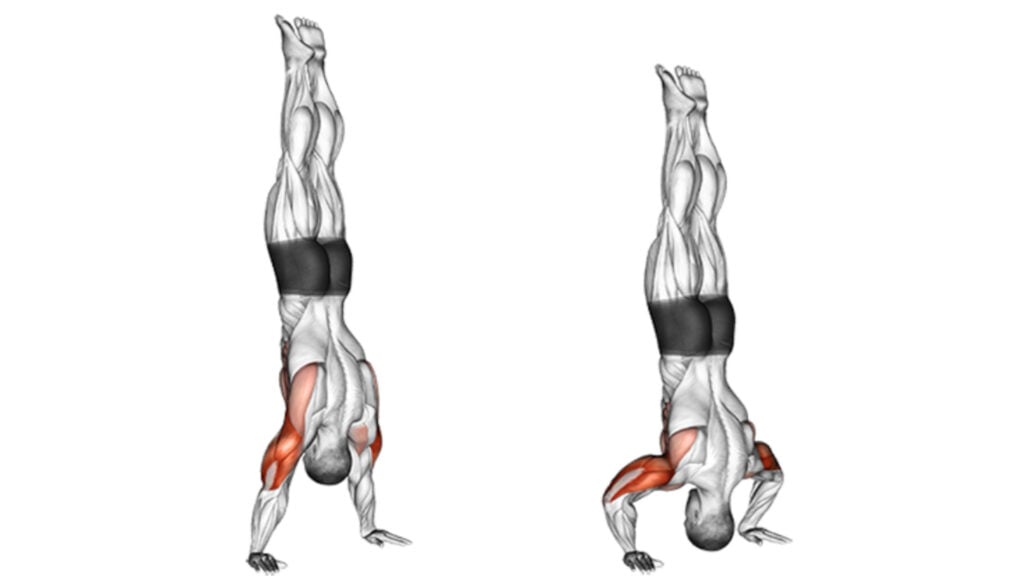
17. Bear Crawl
The Bear Crawl is a dynamic bodyweight exercise that engages multiple muscles, including the shoulders, arms, core, and legs.
It’s a functional movement that mimics the action of crawling on all fours.
This exercise builds strength and endurance in the shoulders by placing continuous tension on them.

18. Arm Circles
Arm Circles are a simple yet effective bodyweight exercise that primarily targets the muscles in the shoulders.
This exercise is often used to warm up the shoulder joints and muscles before engaging in more intense physical activity.
It improves the range of motion and mobility in the shoulder joints.
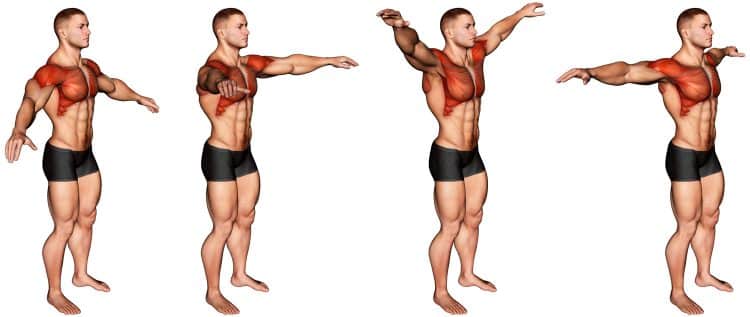
19. Wall Walk
The Wall Walk, also called the Wall Climb, is a bodyweight workout that works all of your body parts. It helps you get stronger, more stable, and more coordinated in your upper and lower body.
To do this exercise, you start in a plank position facing away from a wall. Then, you walk your feet up the wall while moving your hands toward it.
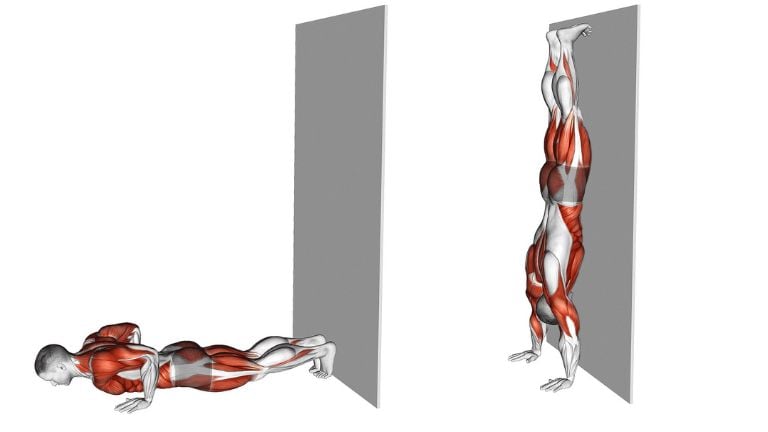
20. Scapular Wall Slides
Scapular wall slides—also known as wall slides or reverse wall slides—are one of the basic exercises that people are taught to practice for improved shoulder rotation, upper back activation, and scapular mobility.
The study found that the group that did wall slide exercises had a significant decrease in pain in the rotator cuff muscles after four weeks.
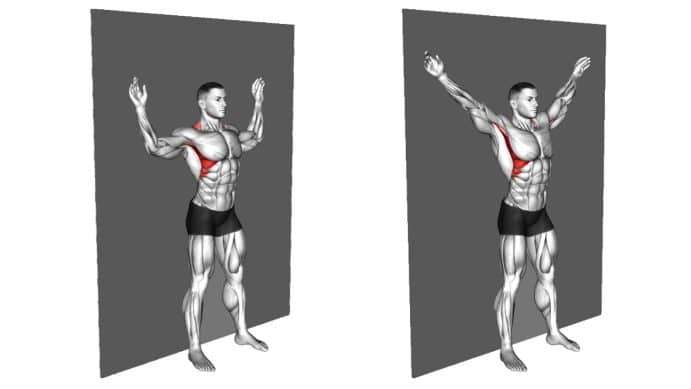
21. Alternating Superman Plank And Reach
The Superman Plank is an isometric training exercise. Before training with this plank variation, you should know how to do the basic planks.
It increases the core-strengthening benefits of a regular plank by balancing on only two limbs. Stability demands increase when the opposite arm and leg are extended.
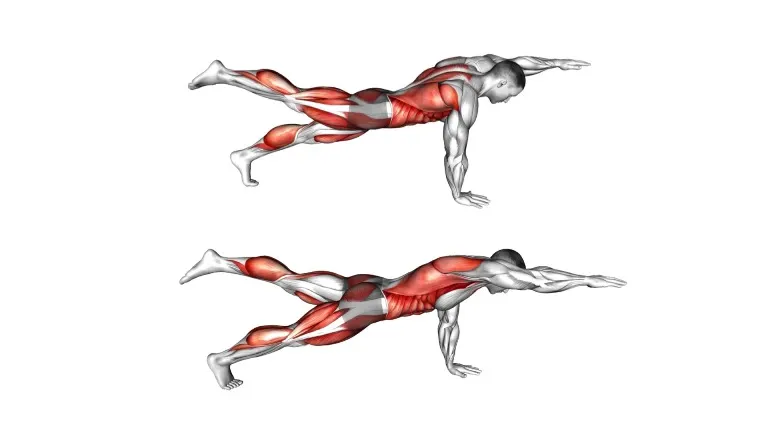
22. Lateral Plank Walk
The Lateral Plank Walk is a full-body exercise mainly targeting your core and shoulders. Take a walk on the wild side as well, as wild as a plank can get.
This move intensely engages your core like a classic plank, but the side-to-side motion also works your arms and delts. Plus, it’ll challenge your balance and stability.
The faster you “walk,” the more challenging this will be for your cardiovascular system. Slow down if you need to dial down the intensity a bit.
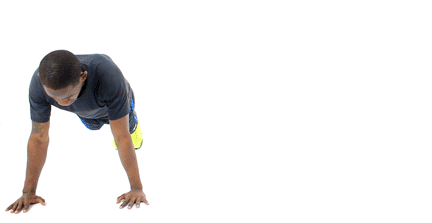
23. Scapula Push Ups
Scapula Push-Ups, or Scap Push–Ups, are among the best exercises for strengthening the upper back muscles and improving shoulder strength and mobility.
The scapular pushup is considered to be more challenging than a conventional pushup because you need to hold a good position on your plank while pushing yourself up.
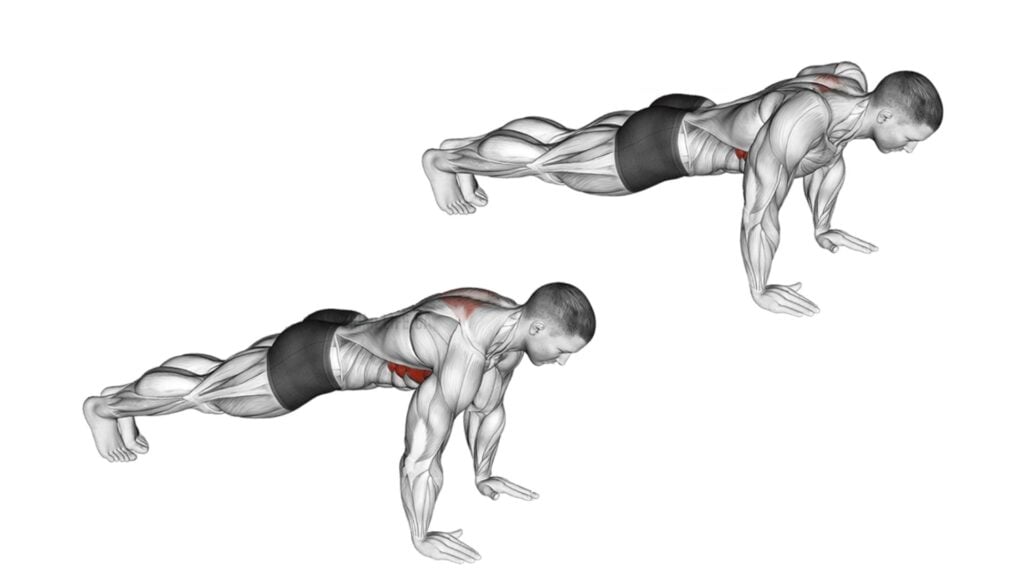
Conclusion
With over 100 shoulder exercises covered, there are plenty of ways to build, strengthen, and challenge the muscles of your shoulders.
The range is extensive, from classic overhead presses to unique variations like the Arnold press and cable rear delt fly.
With this diverse collection of shoulder exercises extending beyond the basic routines, your shoulders will experience unparalleled strength, size, and definition development.
Select your favourites from the list and prepare to witness significant improvements in your shoulders’ muscularity and overall posture.

Manish is a NASM-certified fitness and nutrition coach with over 10 years of experience in weight lifting and fat loss fitness coaching. He specializes in gym-based training and has a lot of knowledge about exercise, lifting technique, biomechanics, and more.
Through “Fit Life Regime,” he generously shares the insights he’s gained over a decade in the field. His goal is to equip others with the knowledge to start their own fitness journey.
